Financial Accounting: Types of Business Transactions, Financial Analysis, Fundamental Principles, Bank Reconciliation
VerifiedAdded on 2023/01/09
|23
|4455
|92
AI Summary
This report provides an analysis of various types of business transactions, financial analysis of Kate's business, fundamental principles of accounting, and the procedure of bank reconciliation. It covers topics such as sales, purchases, payment to suppliers, payment received from customers, borrowing of money, payroll, drawing, single entry and double entry bookkeeping, trial balance, revenue recognition principle, full disclosure principle, and more.
Contribute Materials
Your contribution can guide someone’s learning journey. Share your
documents today.
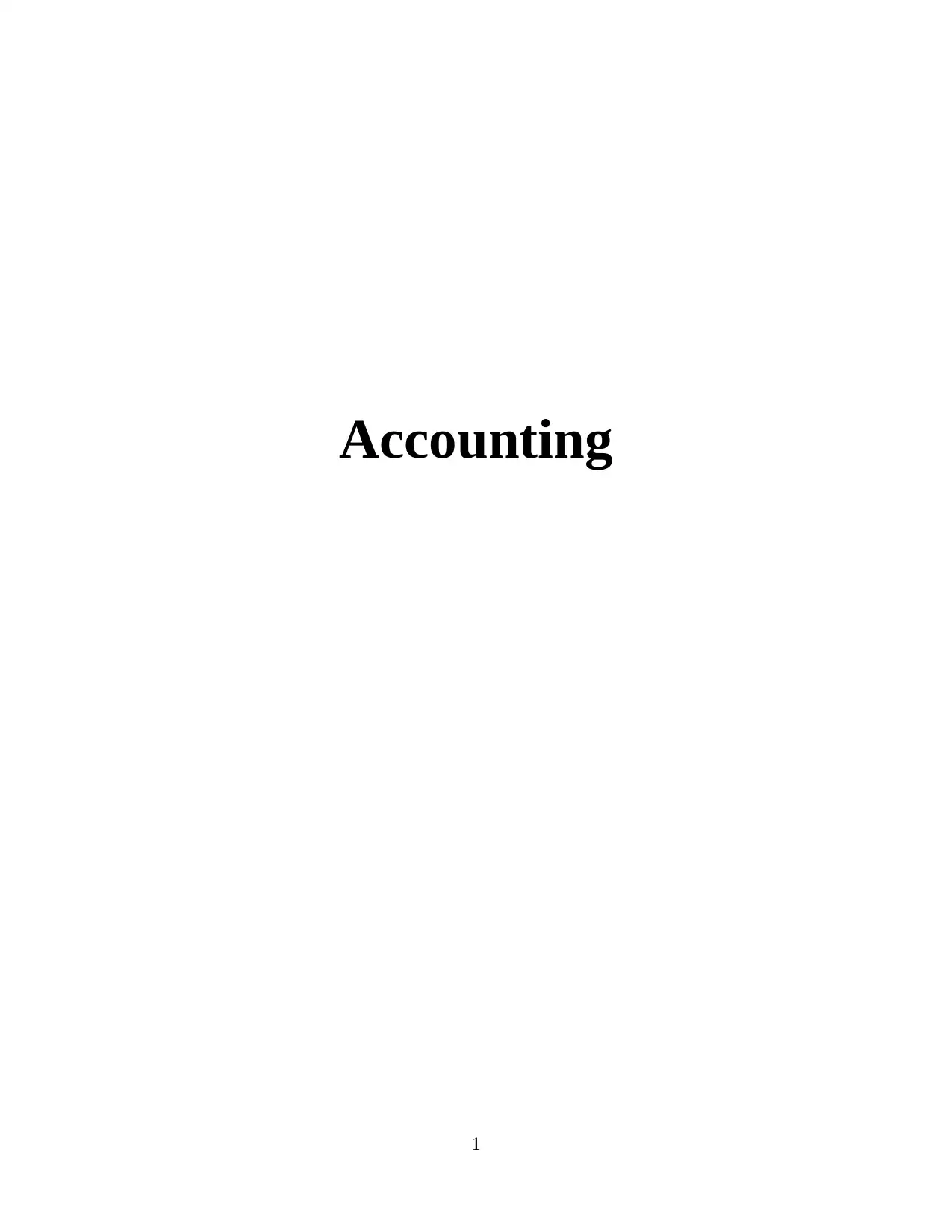
Accounting
1
1
Secure Best Marks with AI Grader
Need help grading? Try our AI Grader for instant feedback on your assignments.
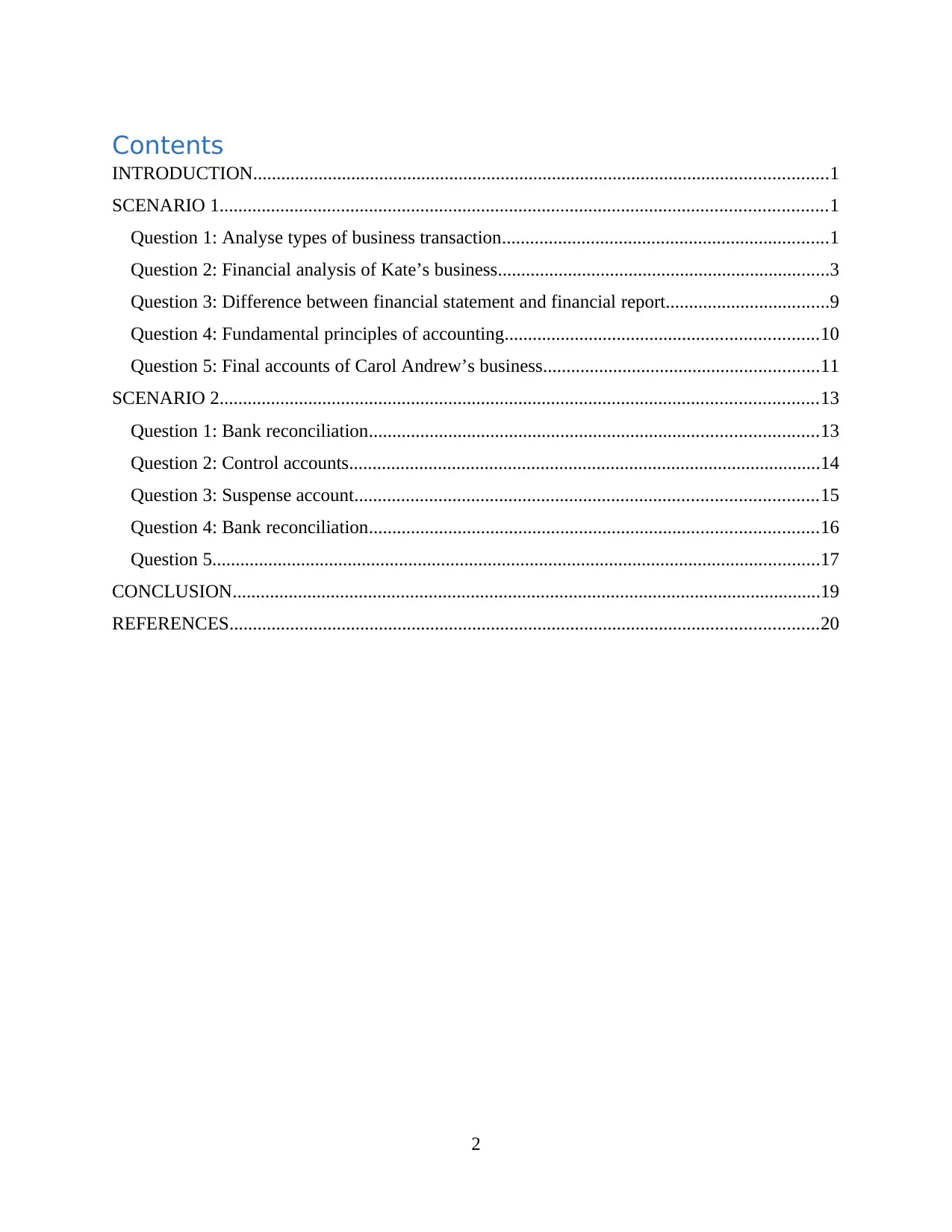
Contents
INTRODUCTION...........................................................................................................................1
SCENARIO 1..................................................................................................................................1
Question 1: Analyse types of business transaction......................................................................1
Question 2: Financial analysis of Kate’s business.......................................................................3
Question 3: Difference between financial statement and financial report...................................9
Question 4: Fundamental principles of accounting...................................................................10
Question 5: Final accounts of Carol Andrew’s business...........................................................11
SCENARIO 2................................................................................................................................13
Question 1: Bank reconciliation................................................................................................13
Question 2: Control accounts.....................................................................................................14
Question 3: Suspense account...................................................................................................15
Question 4: Bank reconciliation................................................................................................16
Question 5..................................................................................................................................17
CONCLUSION..............................................................................................................................19
REFERENCES..............................................................................................................................20
2
INTRODUCTION...........................................................................................................................1
SCENARIO 1..................................................................................................................................1
Question 1: Analyse types of business transaction......................................................................1
Question 2: Financial analysis of Kate’s business.......................................................................3
Question 3: Difference between financial statement and financial report...................................9
Question 4: Fundamental principles of accounting...................................................................10
Question 5: Final accounts of Carol Andrew’s business...........................................................11
SCENARIO 2................................................................................................................................13
Question 1: Bank reconciliation................................................................................................13
Question 2: Control accounts.....................................................................................................14
Question 3: Suspense account...................................................................................................15
Question 4: Bank reconciliation................................................................................................16
Question 5..................................................................................................................................17
CONCLUSION..............................................................................................................................19
REFERENCES..............................................................................................................................20
2
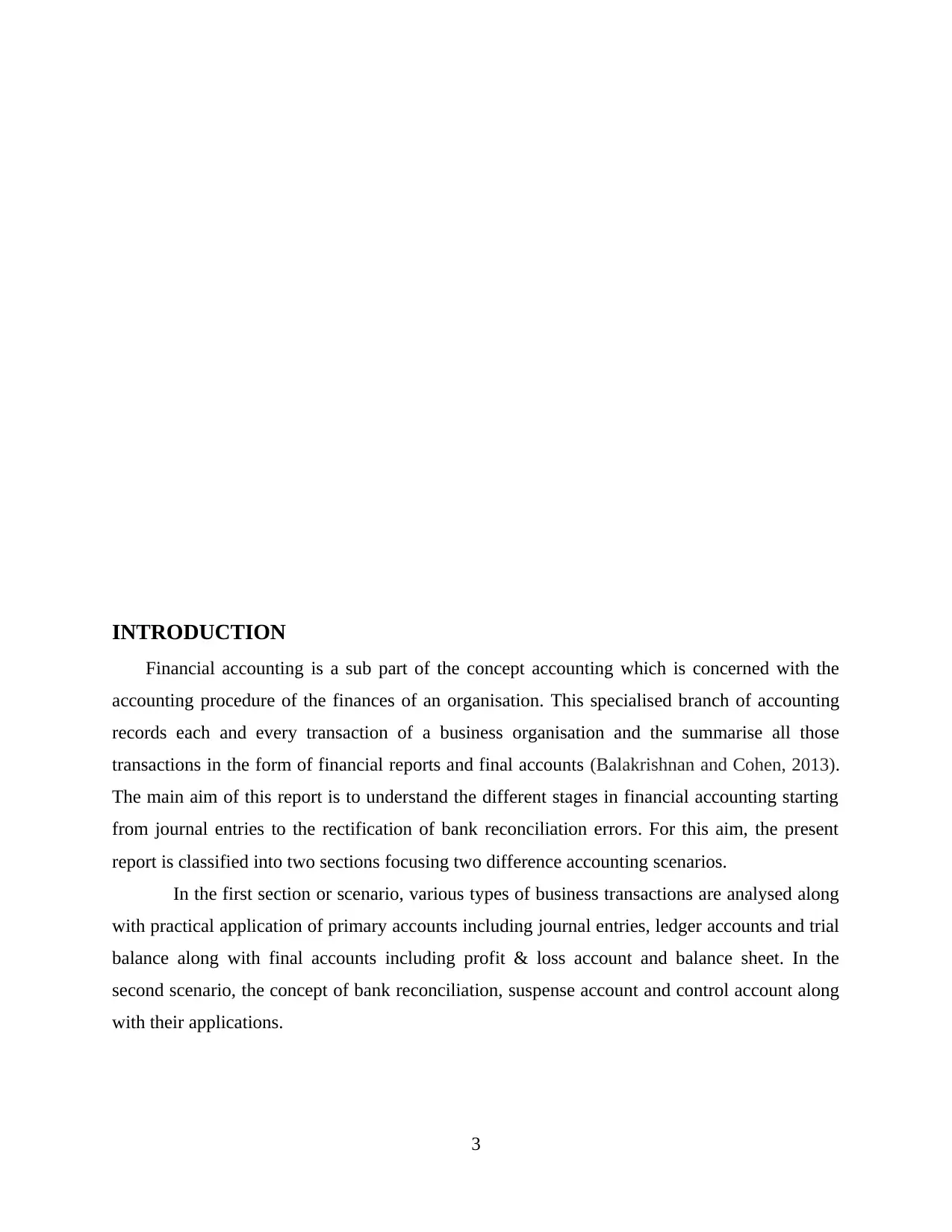
INTRODUCTION
Financial accounting is a sub part of the concept accounting which is concerned with the
accounting procedure of the finances of an organisation. This specialised branch of accounting
records each and every transaction of a business organisation and the summarise all those
transactions in the form of financial reports and final accounts (Balakrishnan and Cohen, 2013).
The main aim of this report is to understand the different stages in financial accounting starting
from journal entries to the rectification of bank reconciliation errors. For this aim, the present
report is classified into two sections focusing two difference accounting scenarios.
In the first section or scenario, various types of business transactions are analysed along
with practical application of primary accounts including journal entries, ledger accounts and trial
balance along with final accounts including profit & loss account and balance sheet. In the
second scenario, the concept of bank reconciliation, suspense account and control account along
with their applications.
3
Financial accounting is a sub part of the concept accounting which is concerned with the
accounting procedure of the finances of an organisation. This specialised branch of accounting
records each and every transaction of a business organisation and the summarise all those
transactions in the form of financial reports and final accounts (Balakrishnan and Cohen, 2013).
The main aim of this report is to understand the different stages in financial accounting starting
from journal entries to the rectification of bank reconciliation errors. For this aim, the present
report is classified into two sections focusing two difference accounting scenarios.
In the first section or scenario, various types of business transactions are analysed along
with practical application of primary accounts including journal entries, ledger accounts and trial
balance along with final accounts including profit & loss account and balance sheet. In the
second scenario, the concept of bank reconciliation, suspense account and control account along
with their applications.
3
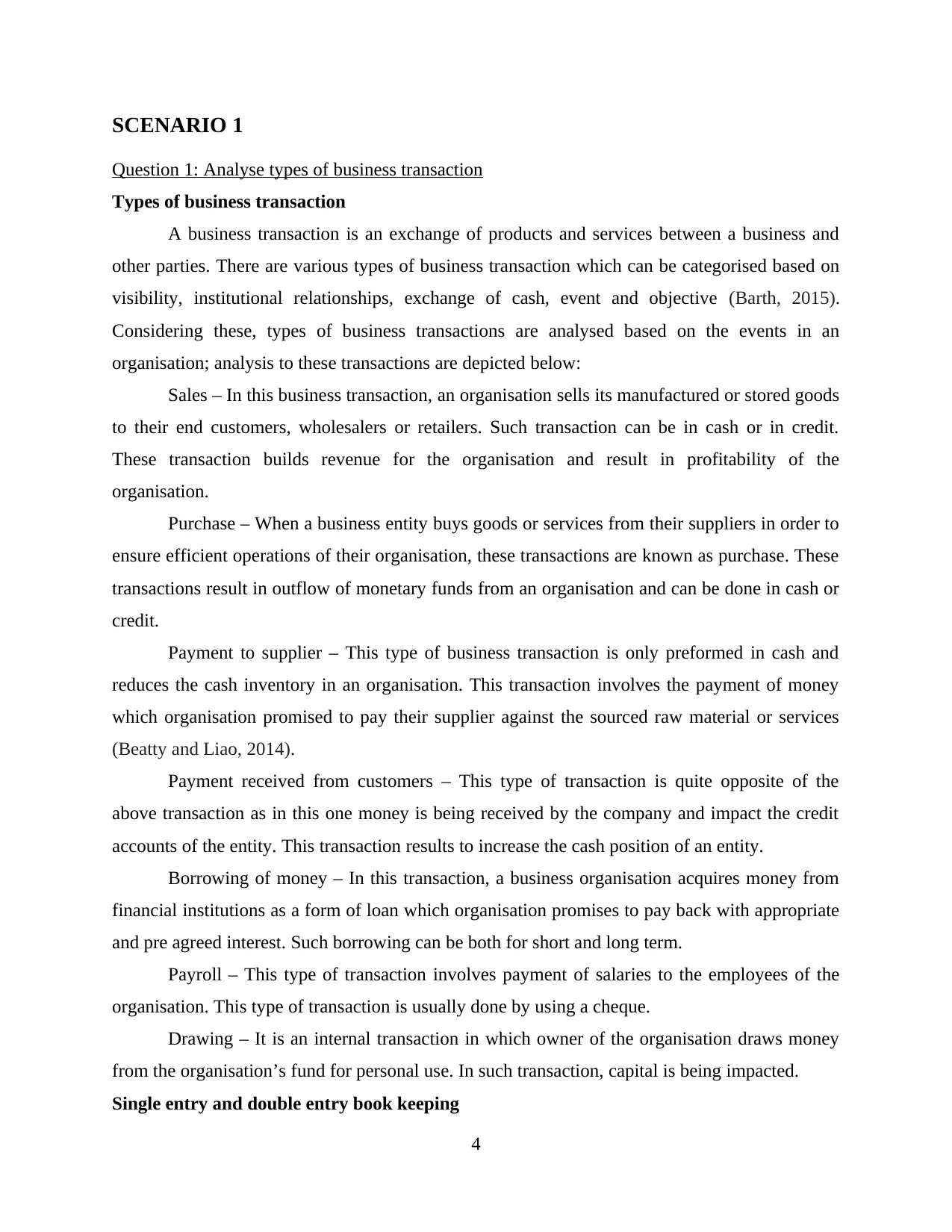
SCENARIO 1
Question 1: Analyse types of business transaction
Types of business transaction
A business transaction is an exchange of products and services between a business and
other parties. There are various types of business transaction which can be categorised based on
visibility, institutional relationships, exchange of cash, event and objective (Barth, 2015).
Considering these, types of business transactions are analysed based on the events in an
organisation; analysis to these transactions are depicted below:
Sales – In this business transaction, an organisation sells its manufactured or stored goods
to their end customers, wholesalers or retailers. Such transaction can be in cash or in credit.
These transaction builds revenue for the organisation and result in profitability of the
organisation.
Purchase – When a business entity buys goods or services from their suppliers in order to
ensure efficient operations of their organisation, these transactions are known as purchase. These
transactions result in outflow of monetary funds from an organisation and can be done in cash or
credit.
Payment to supplier – This type of business transaction is only preformed in cash and
reduces the cash inventory in an organisation. This transaction involves the payment of money
which organisation promised to pay their supplier against the sourced raw material or services
(Beatty and Liao, 2014).
Payment received from customers – This type of transaction is quite opposite of the
above transaction as in this one money is being received by the company and impact the credit
accounts of the entity. This transaction results to increase the cash position of an entity.
Borrowing of money – In this transaction, a business organisation acquires money from
financial institutions as a form of loan which organisation promises to pay back with appropriate
and pre agreed interest. Such borrowing can be both for short and long term.
Payroll – This type of transaction involves payment of salaries to the employees of the
organisation. This type of transaction is usually done by using a cheque.
Drawing – It is an internal transaction in which owner of the organisation draws money
from the organisation’s fund for personal use. In such transaction, capital is being impacted.
Single entry and double entry book keeping
4
Question 1: Analyse types of business transaction
Types of business transaction
A business transaction is an exchange of products and services between a business and
other parties. There are various types of business transaction which can be categorised based on
visibility, institutional relationships, exchange of cash, event and objective (Barth, 2015).
Considering these, types of business transactions are analysed based on the events in an
organisation; analysis to these transactions are depicted below:
Sales – In this business transaction, an organisation sells its manufactured or stored goods
to their end customers, wholesalers or retailers. Such transaction can be in cash or in credit.
These transaction builds revenue for the organisation and result in profitability of the
organisation.
Purchase – When a business entity buys goods or services from their suppliers in order to
ensure efficient operations of their organisation, these transactions are known as purchase. These
transactions result in outflow of monetary funds from an organisation and can be done in cash or
credit.
Payment to supplier – This type of business transaction is only preformed in cash and
reduces the cash inventory in an organisation. This transaction involves the payment of money
which organisation promised to pay their supplier against the sourced raw material or services
(Beatty and Liao, 2014).
Payment received from customers – This type of transaction is quite opposite of the
above transaction as in this one money is being received by the company and impact the credit
accounts of the entity. This transaction results to increase the cash position of an entity.
Borrowing of money – In this transaction, a business organisation acquires money from
financial institutions as a form of loan which organisation promises to pay back with appropriate
and pre agreed interest. Such borrowing can be both for short and long term.
Payroll – This type of transaction involves payment of salaries to the employees of the
organisation. This type of transaction is usually done by using a cheque.
Drawing – It is an internal transaction in which owner of the organisation draws money
from the organisation’s fund for personal use. In such transaction, capital is being impacted.
Single entry and double entry book keeping
4
Secure Best Marks with AI Grader
Need help grading? Try our AI Grader for instant feedback on your assignments.
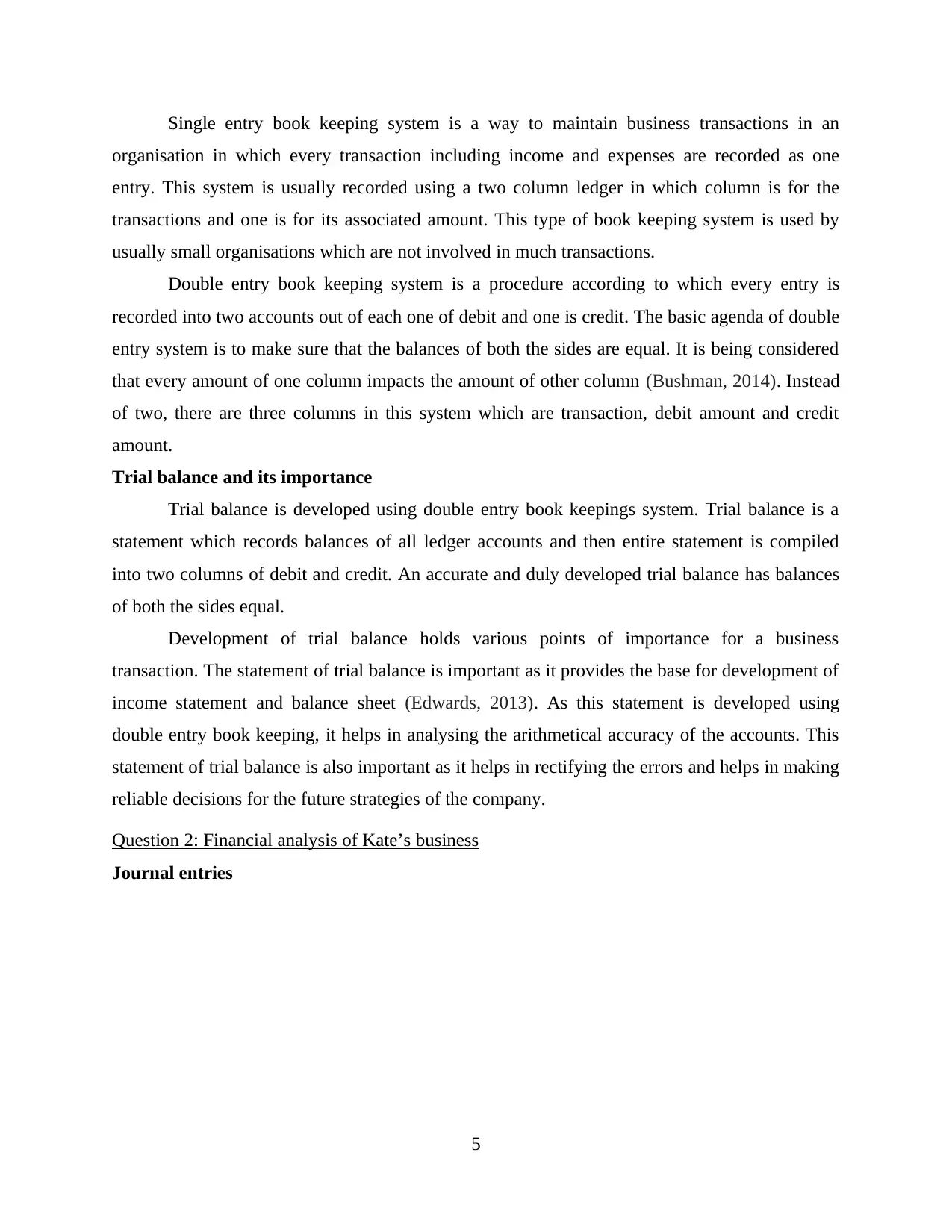
Single entry book keeping system is a way to maintain business transactions in an
organisation in which every transaction including income and expenses are recorded as one
entry. This system is usually recorded using a two column ledger in which column is for the
transactions and one is for its associated amount. This type of book keeping system is used by
usually small organisations which are not involved in much transactions.
Double entry book keeping system is a procedure according to which every entry is
recorded into two accounts out of each one of debit and one is credit. The basic agenda of double
entry system is to make sure that the balances of both the sides are equal. It is being considered
that every amount of one column impacts the amount of other column (Bushman, 2014). Instead
of two, there are three columns in this system which are transaction, debit amount and credit
amount.
Trial balance and its importance
Trial balance is developed using double entry book keepings system. Trial balance is a
statement which records balances of all ledger accounts and then entire statement is compiled
into two columns of debit and credit. An accurate and duly developed trial balance has balances
of both the sides equal.
Development of trial balance holds various points of importance for a business
transaction. The statement of trial balance is important as it provides the base for development of
income statement and balance sheet (Edwards, 2013). As this statement is developed using
double entry book keeping, it helps in analysing the arithmetical accuracy of the accounts. This
statement of trial balance is also important as it helps in rectifying the errors and helps in making
reliable decisions for the future strategies of the company.
Question 2: Financial analysis of Kate’s business
Journal entries
5
organisation in which every transaction including income and expenses are recorded as one
entry. This system is usually recorded using a two column ledger in which column is for the
transactions and one is for its associated amount. This type of book keeping system is used by
usually small organisations which are not involved in much transactions.
Double entry book keeping system is a procedure according to which every entry is
recorded into two accounts out of each one of debit and one is credit. The basic agenda of double
entry system is to make sure that the balances of both the sides are equal. It is being considered
that every amount of one column impacts the amount of other column (Bushman, 2014). Instead
of two, there are three columns in this system which are transaction, debit amount and credit
amount.
Trial balance and its importance
Trial balance is developed using double entry book keepings system. Trial balance is a
statement which records balances of all ledger accounts and then entire statement is compiled
into two columns of debit and credit. An accurate and duly developed trial balance has balances
of both the sides equal.
Development of trial balance holds various points of importance for a business
transaction. The statement of trial balance is important as it provides the base for development of
income statement and balance sheet (Edwards, 2013). As this statement is developed using
double entry book keeping, it helps in analysing the arithmetical accuracy of the accounts. This
statement of trial balance is also important as it helps in rectifying the errors and helps in making
reliable decisions for the future strategies of the company.
Question 2: Financial analysis of Kate’s business
Journal entries
5
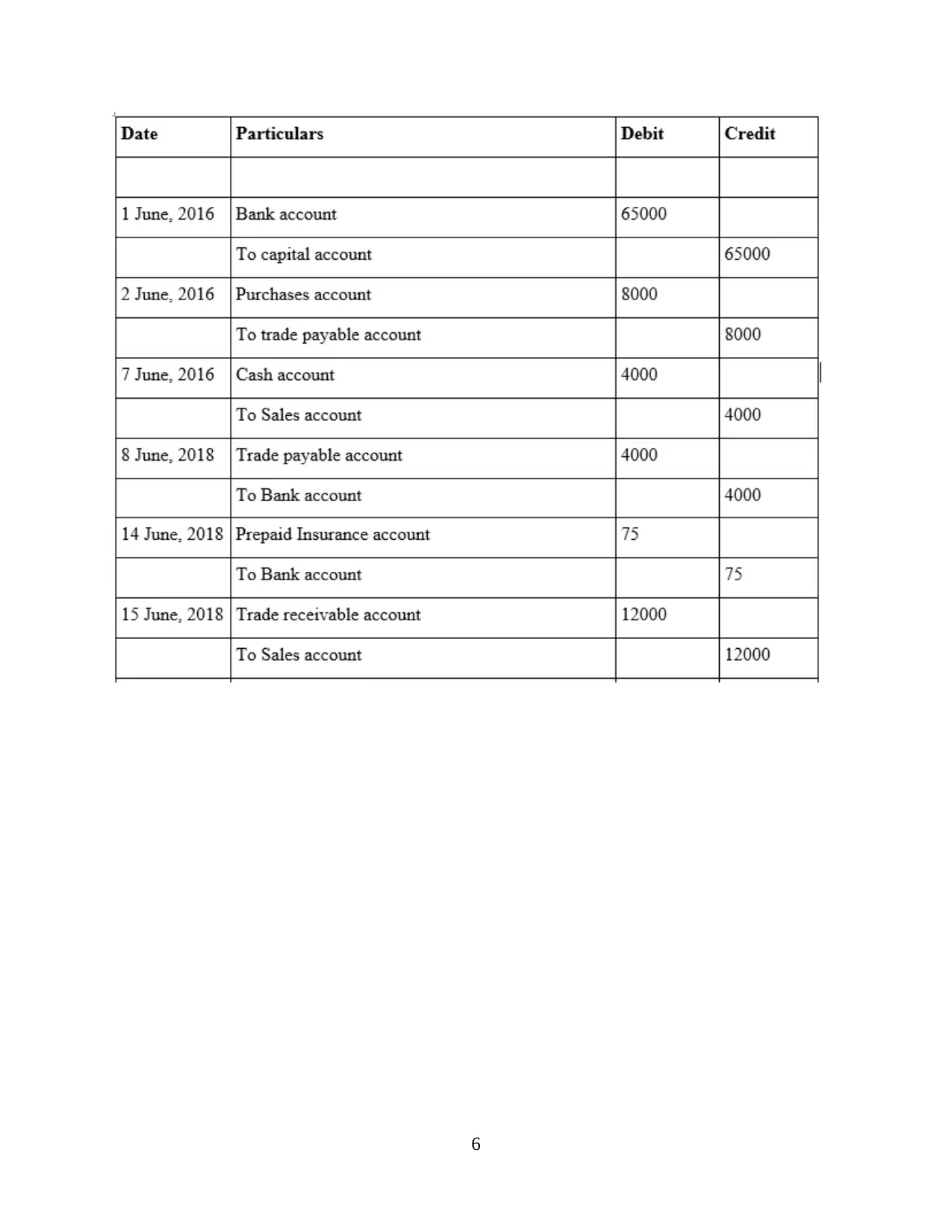
6

Ledger accounts
7
7
Paraphrase This Document
Need a fresh take? Get an instant paraphrase of this document with our AI Paraphraser
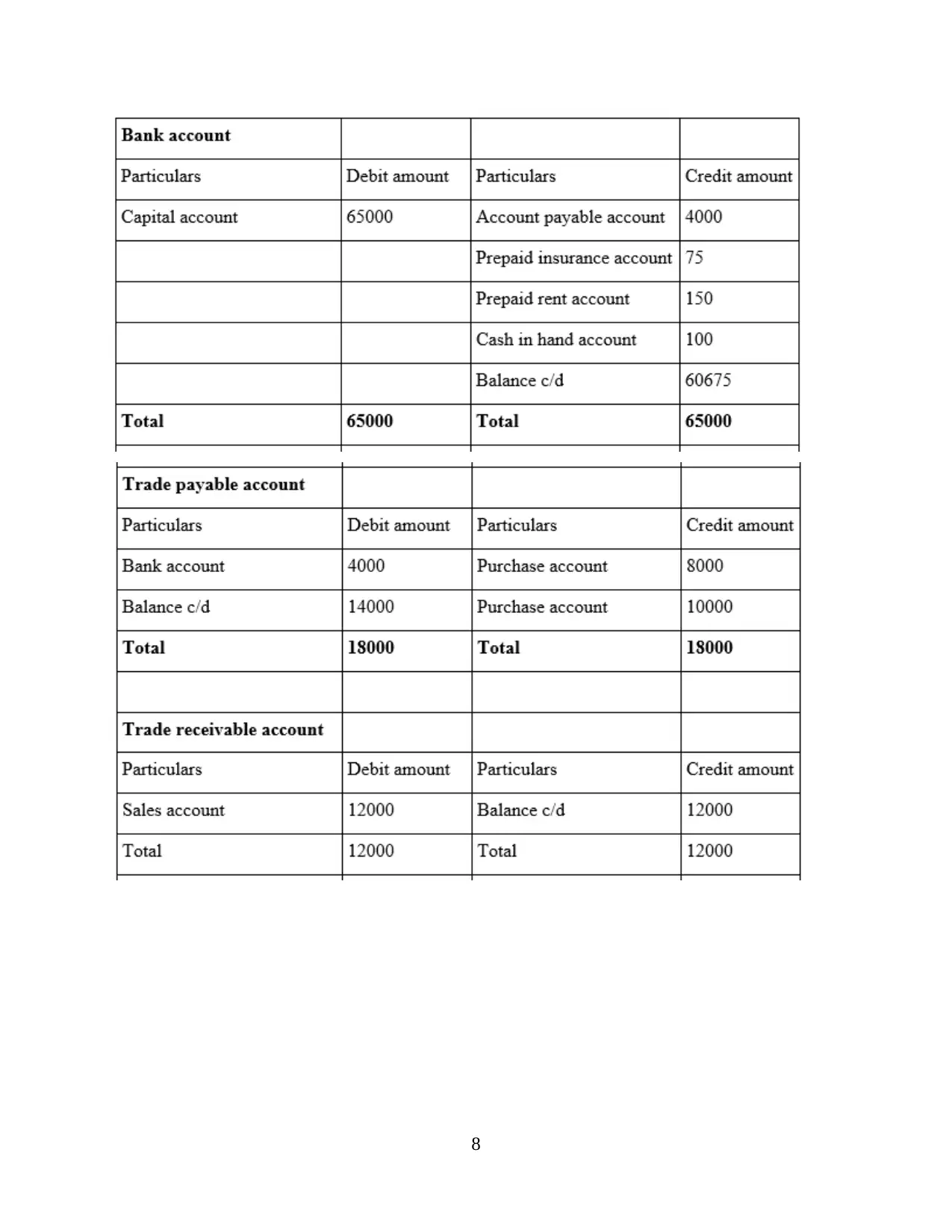
8
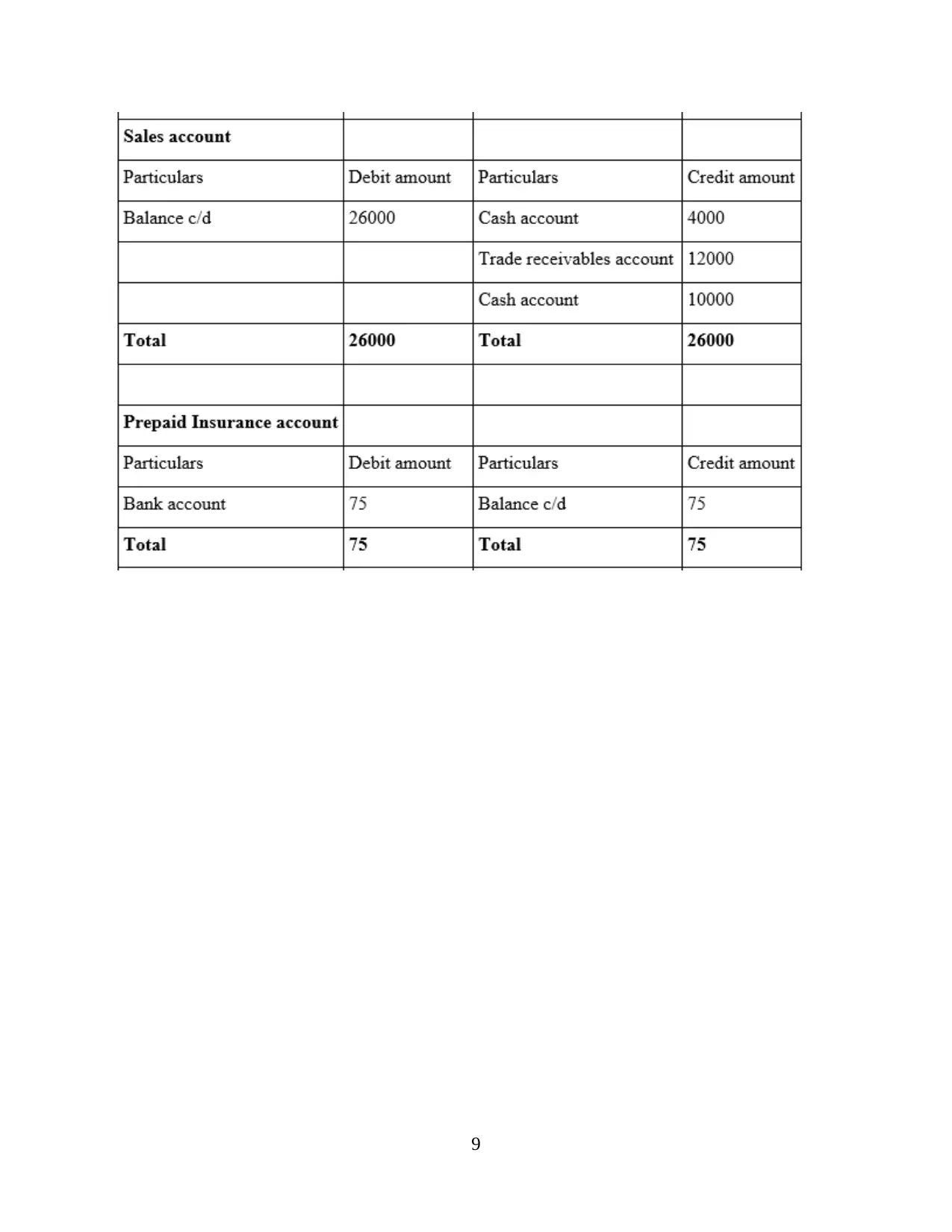
9
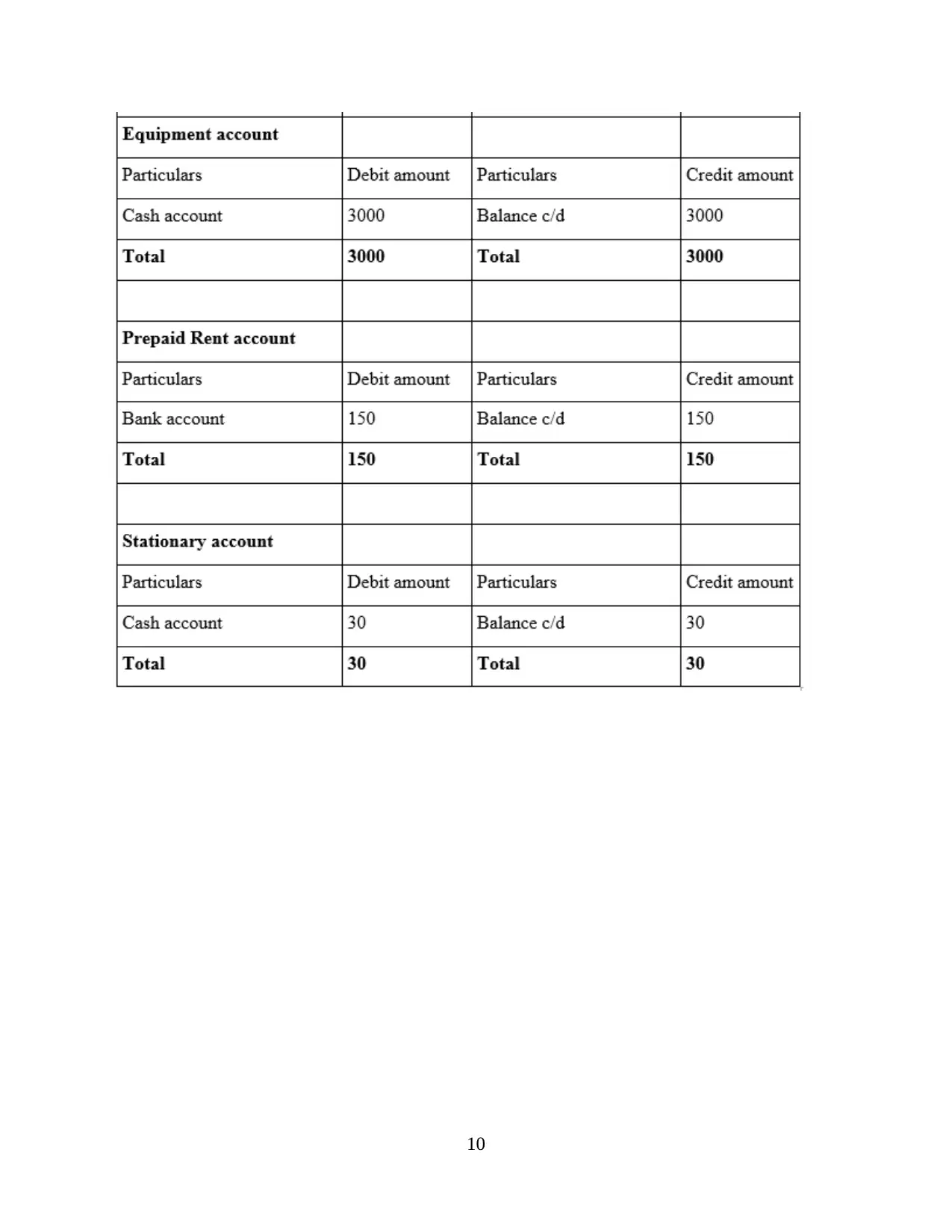
10
Secure Best Marks with AI Grader
Need help grading? Try our AI Grader for instant feedback on your assignments.
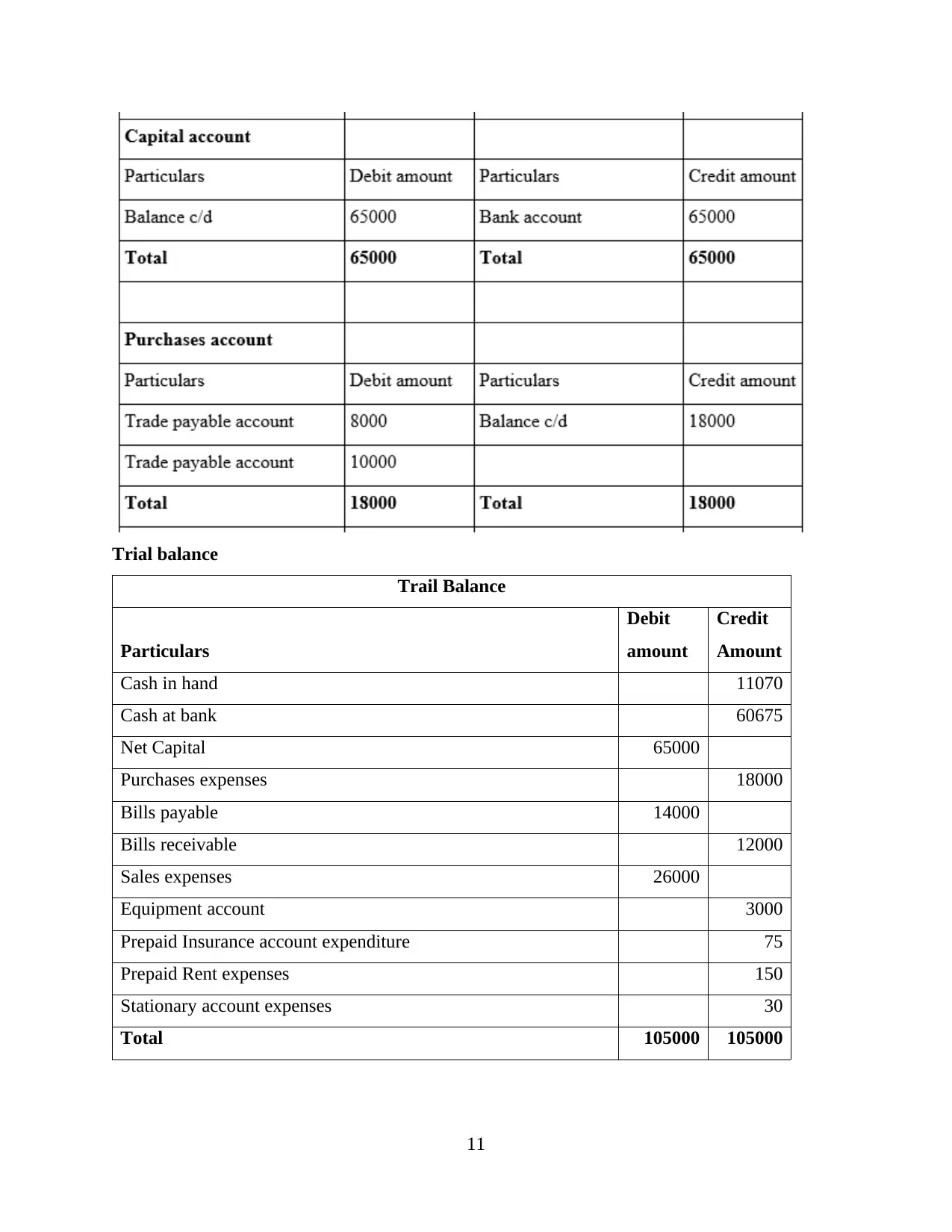
Trial balance
Trail Balance
Particulars
Debit
amount
Credit
Amount
Cash in hand 11070
Cash at bank 60675
Net Capital 65000
Purchases expenses 18000
Bills payable 14000
Bills receivable 12000
Sales expenses 26000
Equipment account 3000
Prepaid Insurance account expenditure 75
Prepaid Rent expenses 150
Stationary account expenses 30
Total 105000 105000
11
Trail Balance
Particulars
Debit
amount
Credit
Amount
Cash in hand 11070
Cash at bank 60675
Net Capital 65000
Purchases expenses 18000
Bills payable 14000
Bills receivable 12000
Sales expenses 26000
Equipment account 3000
Prepaid Insurance account expenditure 75
Prepaid Rent expenses 150
Stationary account expenses 30
Total 105000 105000
11
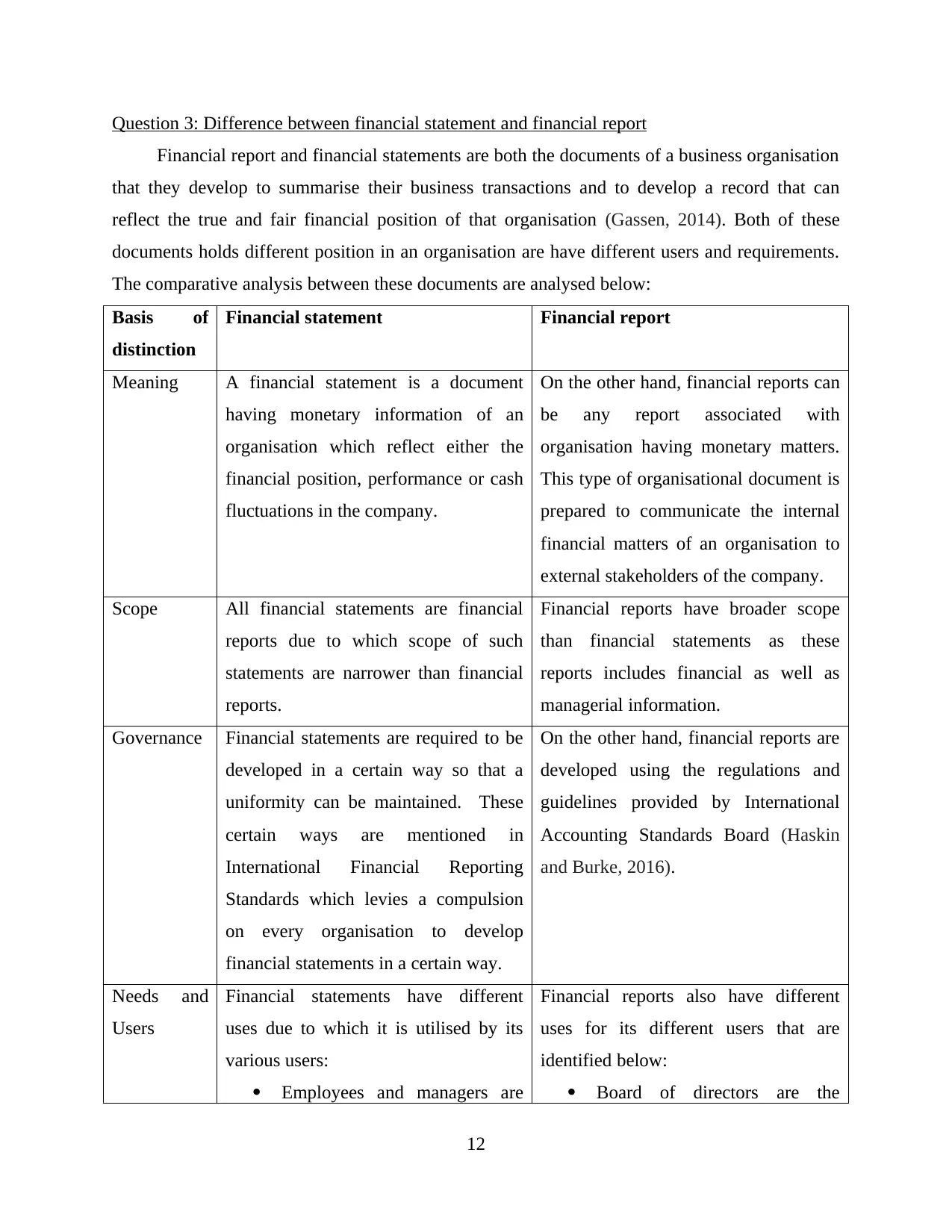
Question 3: Difference between financial statement and financial report
Financial report and financial statements are both the documents of a business organisation
that they develop to summarise their business transactions and to develop a record that can
reflect the true and fair financial position of that organisation (Gassen, 2014). Both of these
documents holds different position in an organisation are have different users and requirements.
The comparative analysis between these documents are analysed below:
Basis of
distinction
Financial statement Financial report
Meaning A financial statement is a document
having monetary information of an
organisation which reflect either the
financial position, performance or cash
fluctuations in the company.
On the other hand, financial reports can
be any report associated with
organisation having monetary matters.
This type of organisational document is
prepared to communicate the internal
financial matters of an organisation to
external stakeholders of the company.
Scope All financial statements are financial
reports due to which scope of such
statements are narrower than financial
reports.
Financial reports have broader scope
than financial statements as these
reports includes financial as well as
managerial information.
Governance Financial statements are required to be
developed in a certain way so that a
uniformity can be maintained. These
certain ways are mentioned in
International Financial Reporting
Standards which levies a compulsion
on every organisation to develop
financial statements in a certain way.
On the other hand, financial reports are
developed using the regulations and
guidelines provided by International
Accounting Standards Board (Haskin
and Burke, 2016).
Needs and
Users
Financial statements have different
uses due to which it is utilised by its
various users:
Employees and managers are
Financial reports also have different
uses for its different users that are
identified below:
Board of directors are the
12
Financial report and financial statements are both the documents of a business organisation
that they develop to summarise their business transactions and to develop a record that can
reflect the true and fair financial position of that organisation (Gassen, 2014). Both of these
documents holds different position in an organisation are have different users and requirements.
The comparative analysis between these documents are analysed below:
Basis of
distinction
Financial statement Financial report
Meaning A financial statement is a document
having monetary information of an
organisation which reflect either the
financial position, performance or cash
fluctuations in the company.
On the other hand, financial reports can
be any report associated with
organisation having monetary matters.
This type of organisational document is
prepared to communicate the internal
financial matters of an organisation to
external stakeholders of the company.
Scope All financial statements are financial
reports due to which scope of such
statements are narrower than financial
reports.
Financial reports have broader scope
than financial statements as these
reports includes financial as well as
managerial information.
Governance Financial statements are required to be
developed in a certain way so that a
uniformity can be maintained. These
certain ways are mentioned in
International Financial Reporting
Standards which levies a compulsion
on every organisation to develop
financial statements in a certain way.
On the other hand, financial reports are
developed using the regulations and
guidelines provided by International
Accounting Standards Board (Haskin
and Burke, 2016).
Needs and
Users
Financial statements have different
uses due to which it is utilised by its
various users:
Employees and managers are
Financial reports also have different
uses for its different users that are
identified below:
Board of directors are the
12
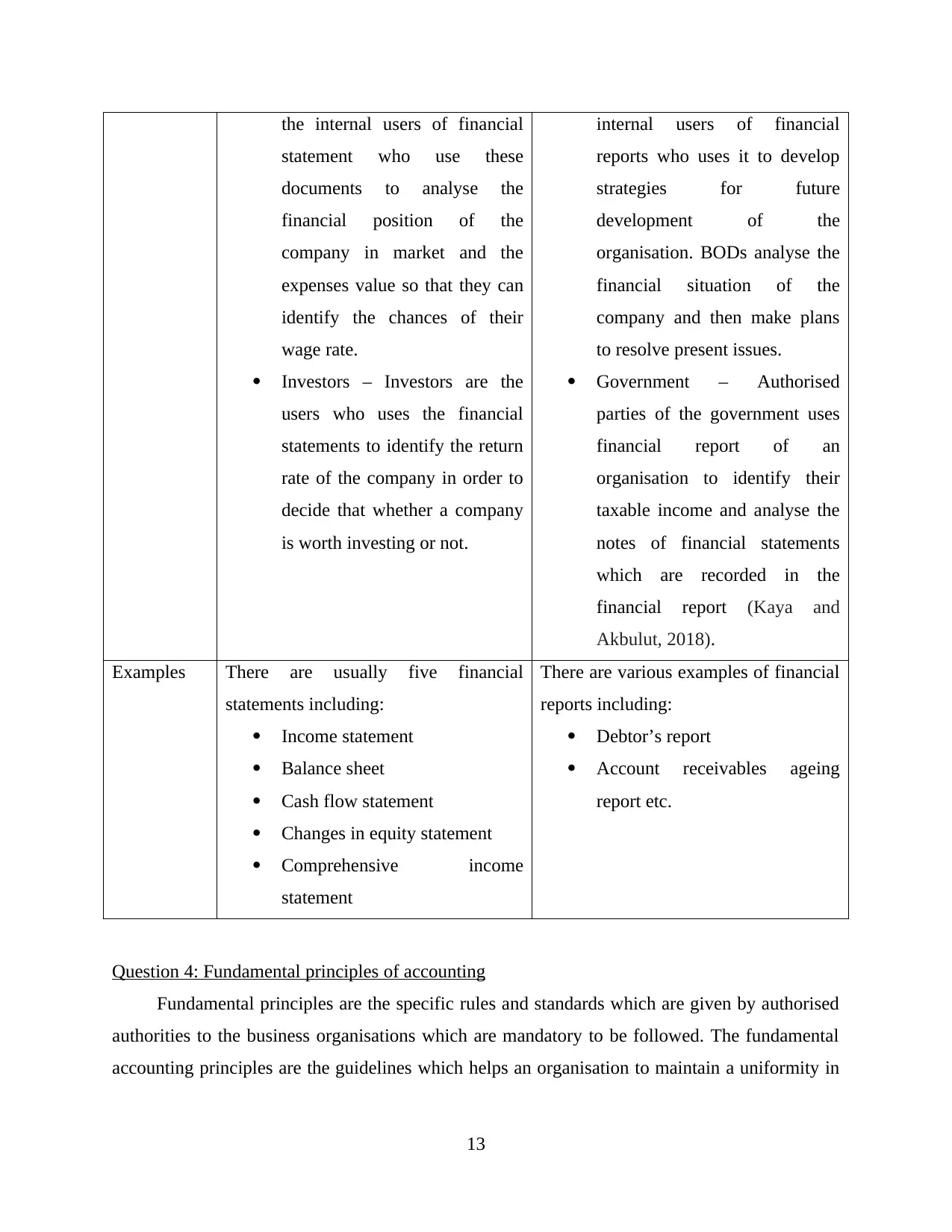
the internal users of financial
statement who use these
documents to analyse the
financial position of the
company in market and the
expenses value so that they can
identify the chances of their
wage rate.
Investors – Investors are the
users who uses the financial
statements to identify the return
rate of the company in order to
decide that whether a company
is worth investing or not.
internal users of financial
reports who uses it to develop
strategies for future
development of the
organisation. BODs analyse the
financial situation of the
company and then make plans
to resolve present issues.
Government – Authorised
parties of the government uses
financial report of an
organisation to identify their
taxable income and analyse the
notes of financial statements
which are recorded in the
financial report (Kaya and
Akbulut, 2018).
Examples There are usually five financial
statements including:
Income statement
Balance sheet
Cash flow statement
Changes in equity statement
Comprehensive income
statement
There are various examples of financial
reports including:
Debtor’s report
Account receivables ageing
report etc.
Question 4: Fundamental principles of accounting
Fundamental principles are the specific rules and standards which are given by authorised
authorities to the business organisations which are mandatory to be followed. The fundamental
accounting principles are the guidelines which helps an organisation to maintain a uniformity in
13
statement who use these
documents to analyse the
financial position of the
company in market and the
expenses value so that they can
identify the chances of their
wage rate.
Investors – Investors are the
users who uses the financial
statements to identify the return
rate of the company in order to
decide that whether a company
is worth investing or not.
internal users of financial
reports who uses it to develop
strategies for future
development of the
organisation. BODs analyse the
financial situation of the
company and then make plans
to resolve present issues.
Government – Authorised
parties of the government uses
financial report of an
organisation to identify their
taxable income and analyse the
notes of financial statements
which are recorded in the
financial report (Kaya and
Akbulut, 2018).
Examples There are usually five financial
statements including:
Income statement
Balance sheet
Cash flow statement
Changes in equity statement
Comprehensive income
statement
There are various examples of financial
reports including:
Debtor’s report
Account receivables ageing
report etc.
Question 4: Fundamental principles of accounting
Fundamental principles are the specific rules and standards which are given by authorised
authorities to the business organisations which are mandatory to be followed. The fundamental
accounting principles are the guidelines which helps an organisation to maintain a uniformity in
13
Paraphrase This Document
Need a fresh take? Get an instant paraphrase of this document with our AI Paraphraser
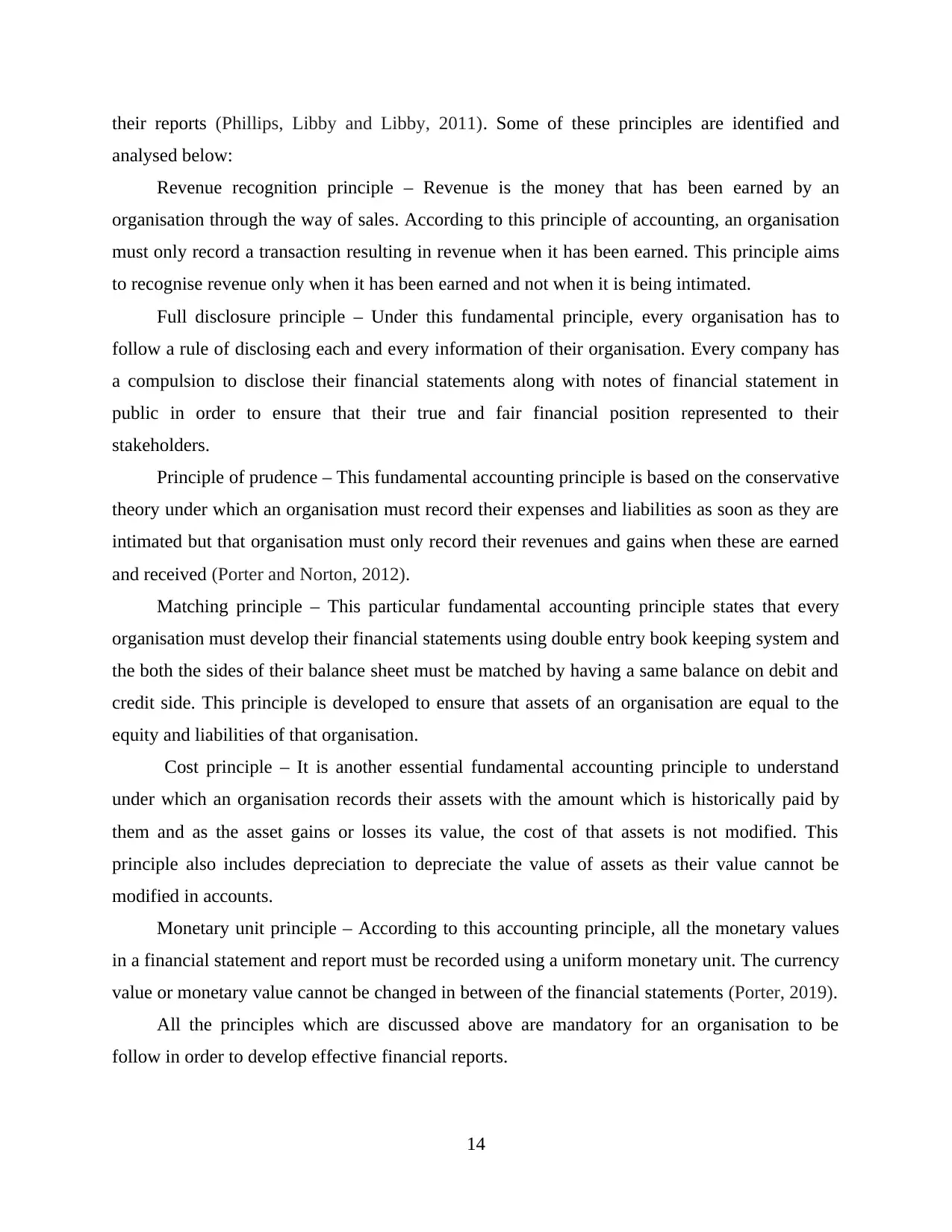
their reports (Phillips, Libby and Libby, 2011). Some of these principles are identified and
analysed below:
Revenue recognition principle – Revenue is the money that has been earned by an
organisation through the way of sales. According to this principle of accounting, an organisation
must only record a transaction resulting in revenue when it has been earned. This principle aims
to recognise revenue only when it has been earned and not when it is being intimated.
Full disclosure principle – Under this fundamental principle, every organisation has to
follow a rule of disclosing each and every information of their organisation. Every company has
a compulsion to disclose their financial statements along with notes of financial statement in
public in order to ensure that their true and fair financial position represented to their
stakeholders.
Principle of prudence – This fundamental accounting principle is based on the conservative
theory under which an organisation must record their expenses and liabilities as soon as they are
intimated but that organisation must only record their revenues and gains when these are earned
and received (Porter and Norton, 2012).
Matching principle – This particular fundamental accounting principle states that every
organisation must develop their financial statements using double entry book keeping system and
the both the sides of their balance sheet must be matched by having a same balance on debit and
credit side. This principle is developed to ensure that assets of an organisation are equal to the
equity and liabilities of that organisation.
Cost principle – It is another essential fundamental accounting principle to understand
under which an organisation records their assets with the amount which is historically paid by
them and as the asset gains or losses its value, the cost of that assets is not modified. This
principle also includes depreciation to depreciate the value of assets as their value cannot be
modified in accounts.
Monetary unit principle – According to this accounting principle, all the monetary values
in a financial statement and report must be recorded using a uniform monetary unit. The currency
value or monetary value cannot be changed in between of the financial statements (Porter, 2019).
All the principles which are discussed above are mandatory for an organisation to be
follow in order to develop effective financial reports.
14
analysed below:
Revenue recognition principle – Revenue is the money that has been earned by an
organisation through the way of sales. According to this principle of accounting, an organisation
must only record a transaction resulting in revenue when it has been earned. This principle aims
to recognise revenue only when it has been earned and not when it is being intimated.
Full disclosure principle – Under this fundamental principle, every organisation has to
follow a rule of disclosing each and every information of their organisation. Every company has
a compulsion to disclose their financial statements along with notes of financial statement in
public in order to ensure that their true and fair financial position represented to their
stakeholders.
Principle of prudence – This fundamental accounting principle is based on the conservative
theory under which an organisation must record their expenses and liabilities as soon as they are
intimated but that organisation must only record their revenues and gains when these are earned
and received (Porter and Norton, 2012).
Matching principle – This particular fundamental accounting principle states that every
organisation must develop their financial statements using double entry book keeping system and
the both the sides of their balance sheet must be matched by having a same balance on debit and
credit side. This principle is developed to ensure that assets of an organisation are equal to the
equity and liabilities of that organisation.
Cost principle – It is another essential fundamental accounting principle to understand
under which an organisation records their assets with the amount which is historically paid by
them and as the asset gains or losses its value, the cost of that assets is not modified. This
principle also includes depreciation to depreciate the value of assets as their value cannot be
modified in accounts.
Monetary unit principle – According to this accounting principle, all the monetary values
in a financial statement and report must be recorded using a uniform monetary unit. The currency
value or monetary value cannot be changed in between of the financial statements (Porter, 2019).
All the principles which are discussed above are mandatory for an organisation to be
follow in order to develop effective financial reports.
14

Question 5: Final accounts of Carol Andrew’s business
Profit and loss account for 31 December 2017
Particular Amount
Revenue 125000
less: sales returns 1500
Total Revenue 123500
Less: Cost of goods sold 83500
Discount received 1000
Rent received in advance 4850
Gross profit 45850
Expenses:
Rent & rates expenditure 1500
Telephone expenses 900
Insurance expenses 7500
Bad debts 1200
Depreciation 5000
Wages and salaries 13200
Provision for bad-debts (934)
Less: Bad debts written off (650) 284
Outstanding expenditure 340
Net profit 15926
Balance sheet
Liabilities Amount Assets Amount
Capital 120800 Bank balance 10594
Less: Drawings 5150 115650 Cash in hand 340
Creditors 3900 Debtors 12500
Rent received 490 Motor expenses 25000
Reserves balance 15926 less: Depreciation 5400 19600
Suspense account 7489 Prepaid insurance 411
15
Profit and loss account for 31 December 2017
Particular Amount
Revenue 125000
less: sales returns 1500
Total Revenue 123500
Less: Cost of goods sold 83500
Discount received 1000
Rent received in advance 4850
Gross profit 45850
Expenses:
Rent & rates expenditure 1500
Telephone expenses 900
Insurance expenses 7500
Bad debts 1200
Depreciation 5000
Wages and salaries 13200
Provision for bad-debts (934)
Less: Bad debts written off (650) 284
Outstanding expenditure 340
Net profit 15926
Balance sheet
Liabilities Amount Assets Amount
Capital 120800 Bank balance 10594
Less: Drawings 5150 115650 Cash in hand 340
Creditors 3900 Debtors 12500
Rent received 490 Motor expenses 25000
Reserves balance 15926 less: Depreciation 5400 19600
Suspense account 7489 Prepaid insurance 411
15
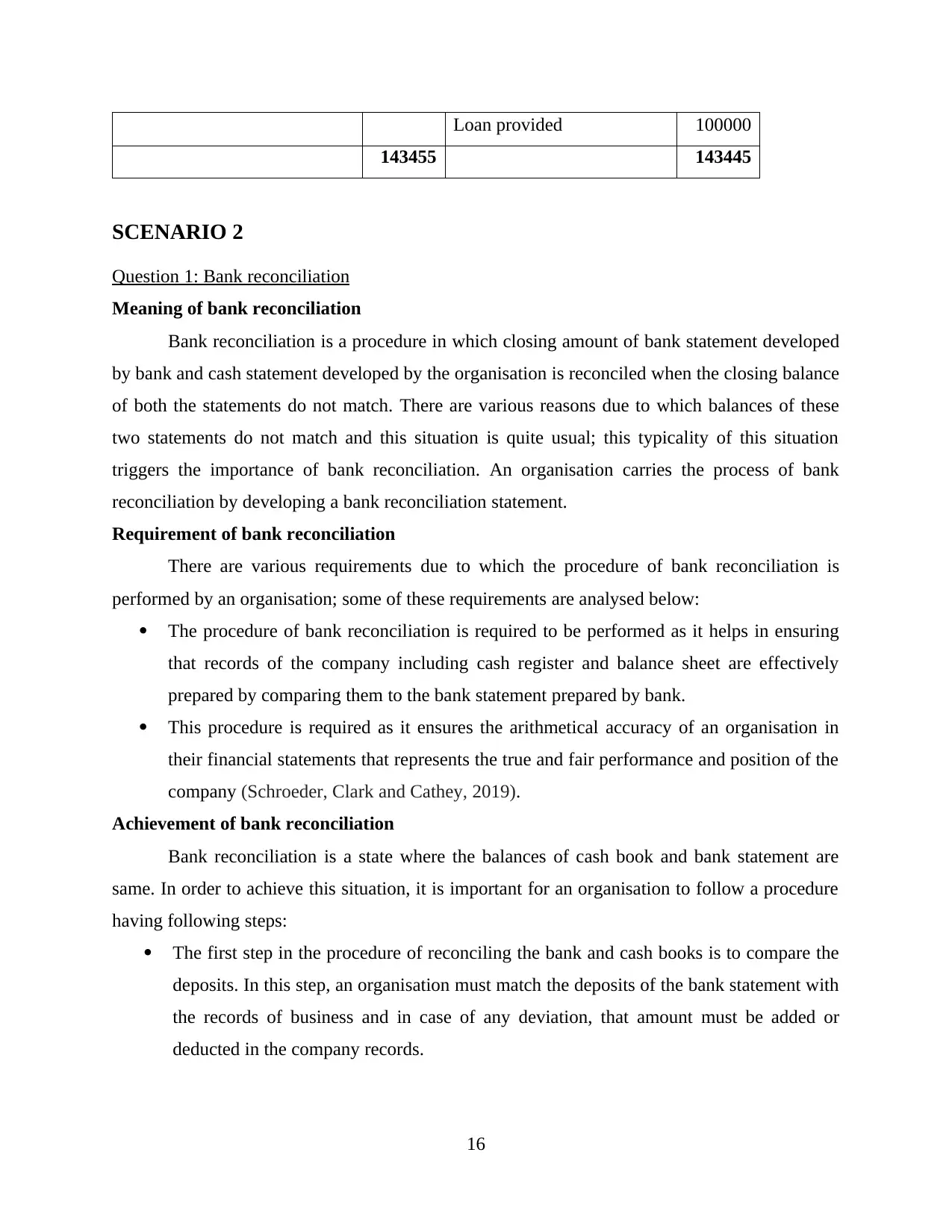
Loan provided 100000
143455 143445
SCENARIO 2
Question 1: Bank reconciliation
Meaning of bank reconciliation
Bank reconciliation is a procedure in which closing amount of bank statement developed
by bank and cash statement developed by the organisation is reconciled when the closing balance
of both the statements do not match. There are various reasons due to which balances of these
two statements do not match and this situation is quite usual; this typicality of this situation
triggers the importance of bank reconciliation. An organisation carries the process of bank
reconciliation by developing a bank reconciliation statement.
Requirement of bank reconciliation
There are various requirements due to which the procedure of bank reconciliation is
performed by an organisation; some of these requirements are analysed below:
The procedure of bank reconciliation is required to be performed as it helps in ensuring
that records of the company including cash register and balance sheet are effectively
prepared by comparing them to the bank statement prepared by bank.
This procedure is required as it ensures the arithmetical accuracy of an organisation in
their financial statements that represents the true and fair performance and position of the
company (Schroeder, Clark and Cathey, 2019).
Achievement of bank reconciliation
Bank reconciliation is a state where the balances of cash book and bank statement are
same. In order to achieve this situation, it is important for an organisation to follow a procedure
having following steps:
The first step in the procedure of reconciling the bank and cash books is to compare the
deposits. In this step, an organisation must match the deposits of the bank statement with
the records of business and in case of any deviation, that amount must be added or
deducted in the company records.
16
143455 143445
SCENARIO 2
Question 1: Bank reconciliation
Meaning of bank reconciliation
Bank reconciliation is a procedure in which closing amount of bank statement developed
by bank and cash statement developed by the organisation is reconciled when the closing balance
of both the statements do not match. There are various reasons due to which balances of these
two statements do not match and this situation is quite usual; this typicality of this situation
triggers the importance of bank reconciliation. An organisation carries the process of bank
reconciliation by developing a bank reconciliation statement.
Requirement of bank reconciliation
There are various requirements due to which the procedure of bank reconciliation is
performed by an organisation; some of these requirements are analysed below:
The procedure of bank reconciliation is required to be performed as it helps in ensuring
that records of the company including cash register and balance sheet are effectively
prepared by comparing them to the bank statement prepared by bank.
This procedure is required as it ensures the arithmetical accuracy of an organisation in
their financial statements that represents the true and fair performance and position of the
company (Schroeder, Clark and Cathey, 2019).
Achievement of bank reconciliation
Bank reconciliation is a state where the balances of cash book and bank statement are
same. In order to achieve this situation, it is important for an organisation to follow a procedure
having following steps:
The first step in the procedure of reconciling the bank and cash books is to compare the
deposits. In this step, an organisation must match the deposits of the bank statement with
the records of business and in case of any deviation, that amount must be added or
deducted in the company records.
16
Secure Best Marks with AI Grader
Need help grading? Try our AI Grader for instant feedback on your assignments.
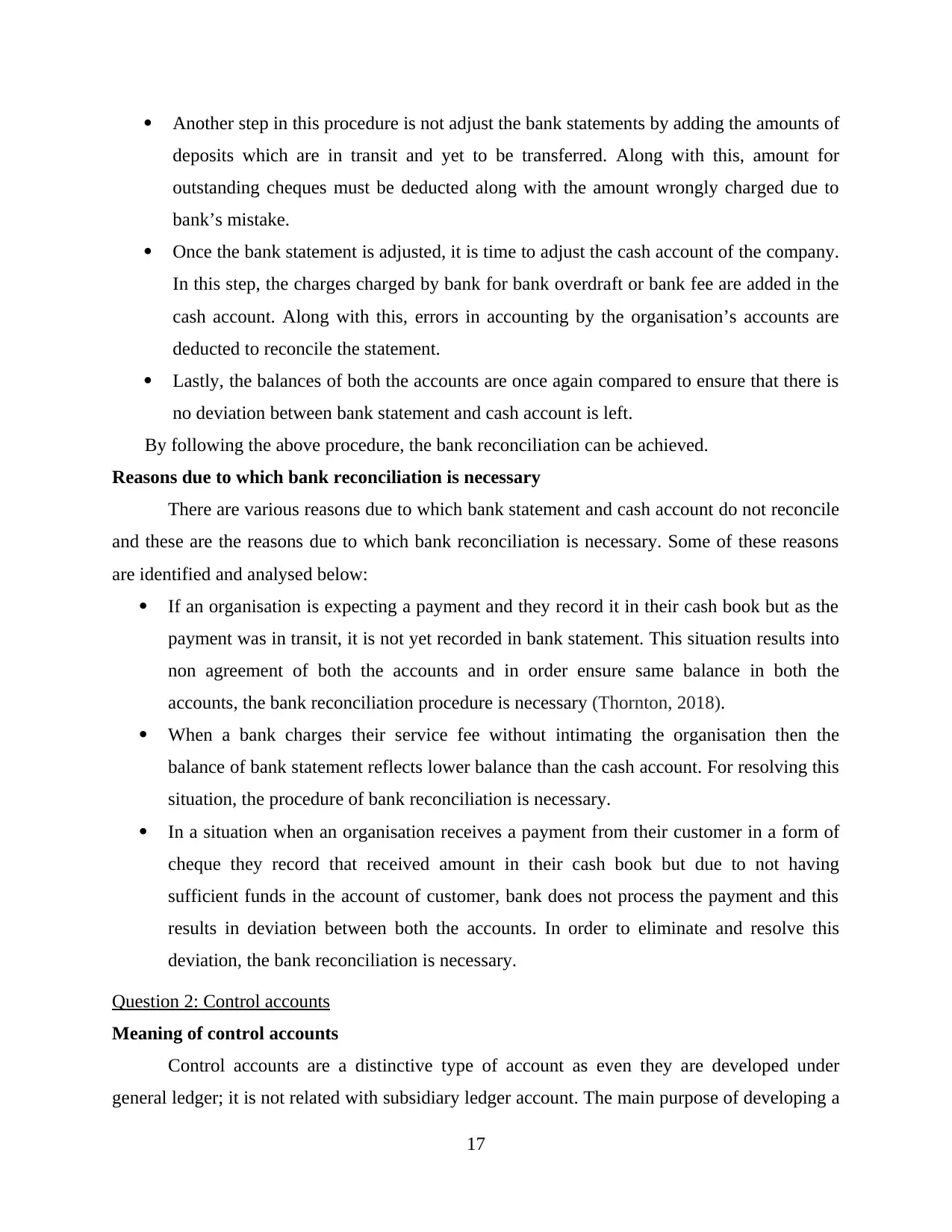
Another step in this procedure is not adjust the bank statements by adding the amounts of
deposits which are in transit and yet to be transferred. Along with this, amount for
outstanding cheques must be deducted along with the amount wrongly charged due to
bank’s mistake.
Once the bank statement is adjusted, it is time to adjust the cash account of the company.
In this step, the charges charged by bank for bank overdraft or bank fee are added in the
cash account. Along with this, errors in accounting by the organisation’s accounts are
deducted to reconcile the statement.
Lastly, the balances of both the accounts are once again compared to ensure that there is
no deviation between bank statement and cash account is left.
By following the above procedure, the bank reconciliation can be achieved.
Reasons due to which bank reconciliation is necessary
There are various reasons due to which bank statement and cash account do not reconcile
and these are the reasons due to which bank reconciliation is necessary. Some of these reasons
are identified and analysed below:
If an organisation is expecting a payment and they record it in their cash book but as the
payment was in transit, it is not yet recorded in bank statement. This situation results into
non agreement of both the accounts and in order ensure same balance in both the
accounts, the bank reconciliation procedure is necessary (Thornton, 2018).
When a bank charges their service fee without intimating the organisation then the
balance of bank statement reflects lower balance than the cash account. For resolving this
situation, the procedure of bank reconciliation is necessary.
In a situation when an organisation receives a payment from their customer in a form of
cheque they record that received amount in their cash book but due to not having
sufficient funds in the account of customer, bank does not process the payment and this
results in deviation between both the accounts. In order to eliminate and resolve this
deviation, the bank reconciliation is necessary.
Question 2: Control accounts
Meaning of control accounts
Control accounts are a distinctive type of account as even they are developed under
general ledger; it is not related with subsidiary ledger account. The main purpose of developing a
17
deposits which are in transit and yet to be transferred. Along with this, amount for
outstanding cheques must be deducted along with the amount wrongly charged due to
bank’s mistake.
Once the bank statement is adjusted, it is time to adjust the cash account of the company.
In this step, the charges charged by bank for bank overdraft or bank fee are added in the
cash account. Along with this, errors in accounting by the organisation’s accounts are
deducted to reconcile the statement.
Lastly, the balances of both the accounts are once again compared to ensure that there is
no deviation between bank statement and cash account is left.
By following the above procedure, the bank reconciliation can be achieved.
Reasons due to which bank reconciliation is necessary
There are various reasons due to which bank statement and cash account do not reconcile
and these are the reasons due to which bank reconciliation is necessary. Some of these reasons
are identified and analysed below:
If an organisation is expecting a payment and they record it in their cash book but as the
payment was in transit, it is not yet recorded in bank statement. This situation results into
non agreement of both the accounts and in order ensure same balance in both the
accounts, the bank reconciliation procedure is necessary (Thornton, 2018).
When a bank charges their service fee without intimating the organisation then the
balance of bank statement reflects lower balance than the cash account. For resolving this
situation, the procedure of bank reconciliation is necessary.
In a situation when an organisation receives a payment from their customer in a form of
cheque they record that received amount in their cash book but due to not having
sufficient funds in the account of customer, bank does not process the payment and this
results in deviation between both the accounts. In order to eliminate and resolve this
deviation, the bank reconciliation is necessary.
Question 2: Control accounts
Meaning of control accounts
Control accounts are a distinctive type of account as even they are developed under
general ledger; it is not related with subsidiary ledger account. The main purpose of developing a
17
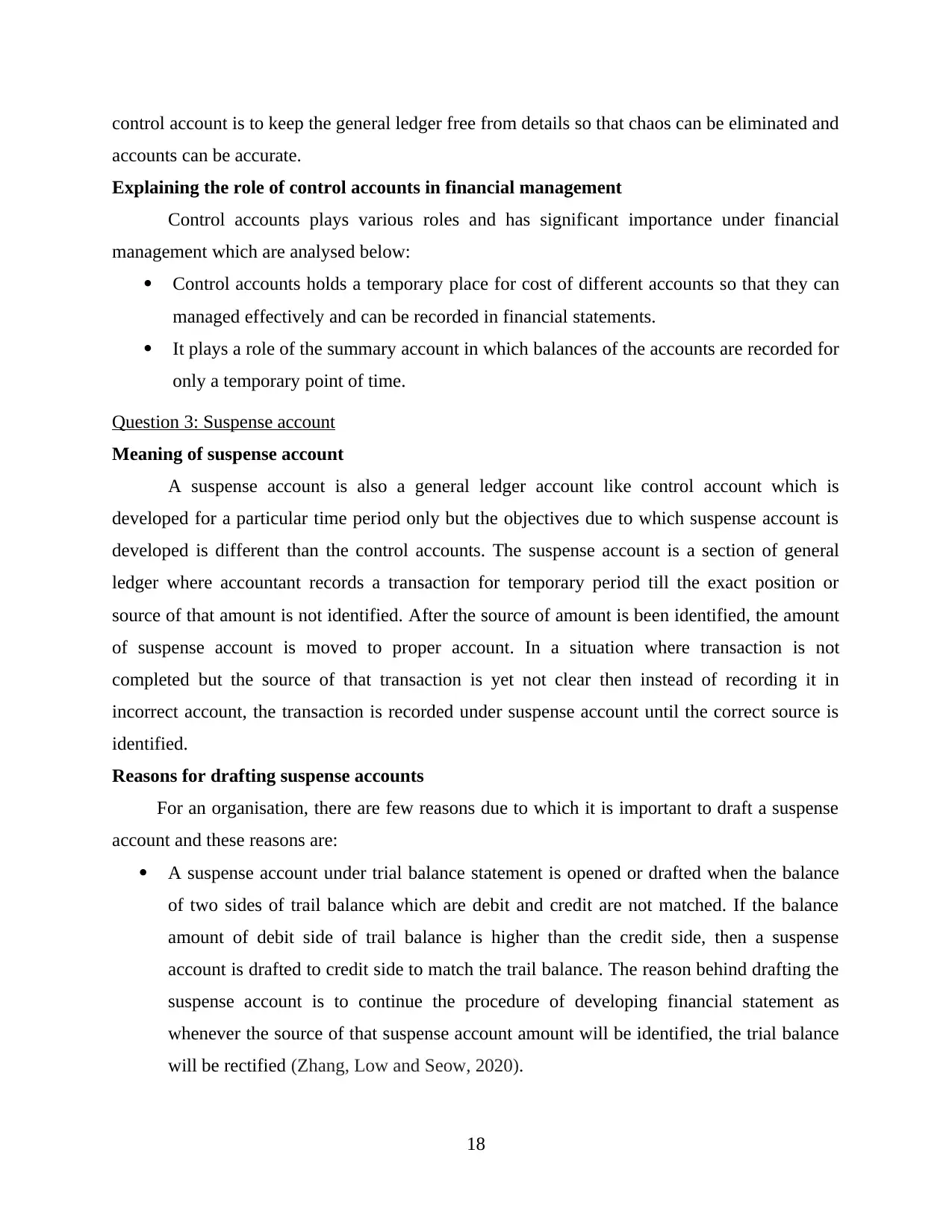
control account is to keep the general ledger free from details so that chaos can be eliminated and
accounts can be accurate.
Explaining the role of control accounts in financial management
Control accounts plays various roles and has significant importance under financial
management which are analysed below:
Control accounts holds a temporary place for cost of different accounts so that they can
managed effectively and can be recorded in financial statements.
It plays a role of the summary account in which balances of the accounts are recorded for
only a temporary point of time.
Question 3: Suspense account
Meaning of suspense account
A suspense account is also a general ledger account like control account which is
developed for a particular time period only but the objectives due to which suspense account is
developed is different than the control accounts. The suspense account is a section of general
ledger where accountant records a transaction for temporary period till the exact position or
source of that amount is not identified. After the source of amount is been identified, the amount
of suspense account is moved to proper account. In a situation where transaction is not
completed but the source of that transaction is yet not clear then instead of recording it in
incorrect account, the transaction is recorded under suspense account until the correct source is
identified.
Reasons for drafting suspense accounts
For an organisation, there are few reasons due to which it is important to draft a suspense
account and these reasons are:
A suspense account under trial balance statement is opened or drafted when the balance
of two sides of trail balance which are debit and credit are not matched. If the balance
amount of debit side of trail balance is higher than the credit side, then a suspense
account is drafted to credit side to match the trail balance. The reason behind drafting the
suspense account is to continue the procedure of developing financial statement as
whenever the source of that suspense account amount will be identified, the trial balance
will be rectified (Zhang, Low and Seow, 2020).
18
accounts can be accurate.
Explaining the role of control accounts in financial management
Control accounts plays various roles and has significant importance under financial
management which are analysed below:
Control accounts holds a temporary place for cost of different accounts so that they can
managed effectively and can be recorded in financial statements.
It plays a role of the summary account in which balances of the accounts are recorded for
only a temporary point of time.
Question 3: Suspense account
Meaning of suspense account
A suspense account is also a general ledger account like control account which is
developed for a particular time period only but the objectives due to which suspense account is
developed is different than the control accounts. The suspense account is a section of general
ledger where accountant records a transaction for temporary period till the exact position or
source of that amount is not identified. After the source of amount is been identified, the amount
of suspense account is moved to proper account. In a situation where transaction is not
completed but the source of that transaction is yet not clear then instead of recording it in
incorrect account, the transaction is recorded under suspense account until the correct source is
identified.
Reasons for drafting suspense accounts
For an organisation, there are few reasons due to which it is important to draft a suspense
account and these reasons are:
A suspense account under trial balance statement is opened or drafted when the balance
of two sides of trail balance which are debit and credit are not matched. If the balance
amount of debit side of trail balance is higher than the credit side, then a suspense
account is drafted to credit side to match the trail balance. The reason behind drafting the
suspense account is to continue the procedure of developing financial statement as
whenever the source of that suspense account amount will be identified, the trial balance
will be rectified (Zhang, Low and Seow, 2020).
18
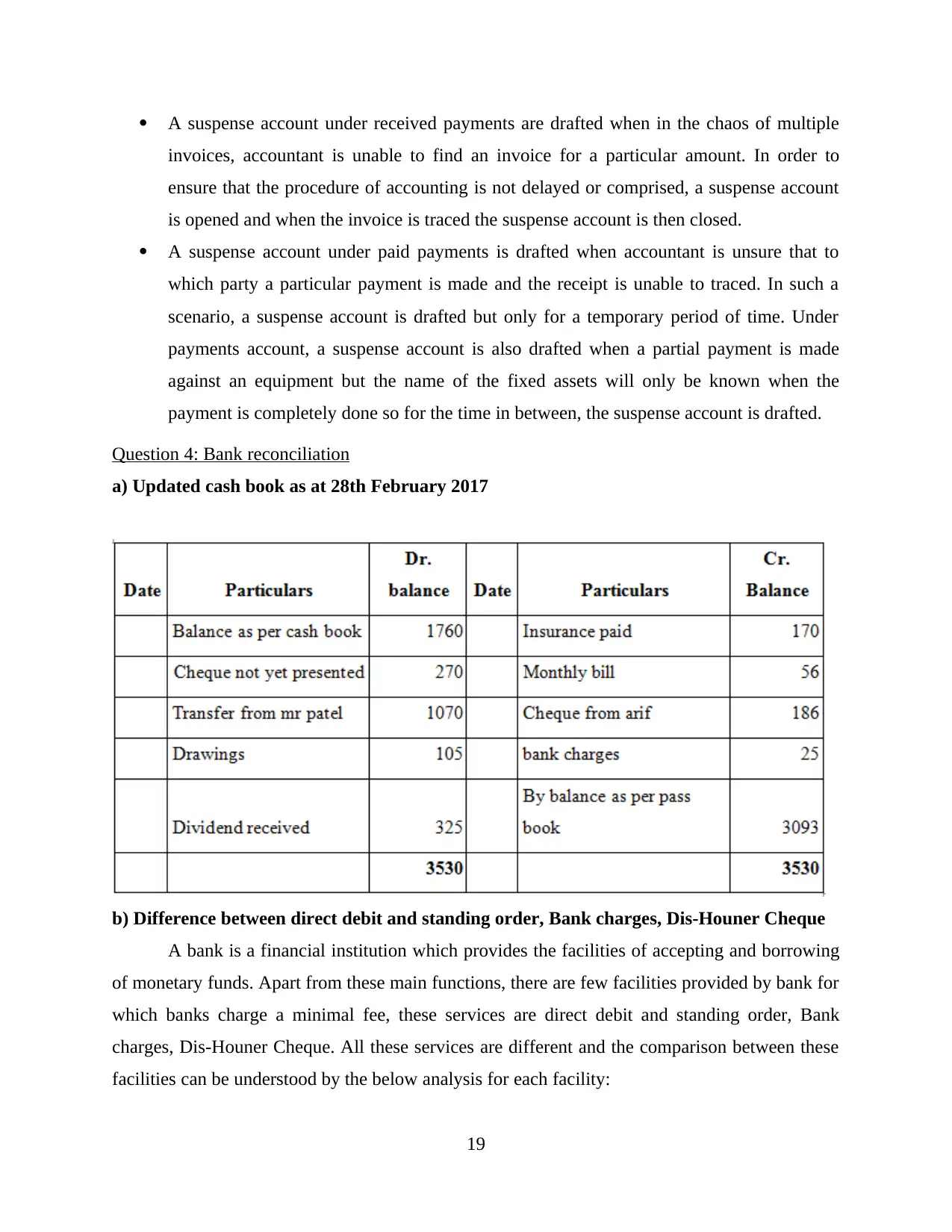
A suspense account under received payments are drafted when in the chaos of multiple
invoices, accountant is unable to find an invoice for a particular amount. In order to
ensure that the procedure of accounting is not delayed or comprised, a suspense account
is opened and when the invoice is traced the suspense account is then closed.
A suspense account under paid payments is drafted when accountant is unsure that to
which party a particular payment is made and the receipt is unable to traced. In such a
scenario, a suspense account is drafted but only for a temporary period of time. Under
payments account, a suspense account is also drafted when a partial payment is made
against an equipment but the name of the fixed assets will only be known when the
payment is completely done so for the time in between, the suspense account is drafted.
Question 4: Bank reconciliation
a) Updated cash book as at 28th February 2017
b) Difference between direct debit and standing order, Bank charges, Dis-Houner Cheque
A bank is a financial institution which provides the facilities of accepting and borrowing
of monetary funds. Apart from these main functions, there are few facilities provided by bank for
which banks charge a minimal fee, these services are direct debit and standing order, Bank
charges, Dis-Houner Cheque. All these services are different and the comparison between these
facilities can be understood by the below analysis for each facility:
19
invoices, accountant is unable to find an invoice for a particular amount. In order to
ensure that the procedure of accounting is not delayed or comprised, a suspense account
is opened and when the invoice is traced the suspense account is then closed.
A suspense account under paid payments is drafted when accountant is unsure that to
which party a particular payment is made and the receipt is unable to traced. In such a
scenario, a suspense account is drafted but only for a temporary period of time. Under
payments account, a suspense account is also drafted when a partial payment is made
against an equipment but the name of the fixed assets will only be known when the
payment is completely done so for the time in between, the suspense account is drafted.
Question 4: Bank reconciliation
a) Updated cash book as at 28th February 2017
b) Difference between direct debit and standing order, Bank charges, Dis-Houner Cheque
A bank is a financial institution which provides the facilities of accepting and borrowing
of monetary funds. Apart from these main functions, there are few facilities provided by bank for
which banks charge a minimal fee, these services are direct debit and standing order, Bank
charges, Dis-Houner Cheque. All these services are different and the comparison between these
facilities can be understood by the below analysis for each facility:
19
Paraphrase This Document
Need a fresh take? Get an instant paraphrase of this document with our AI Paraphraser
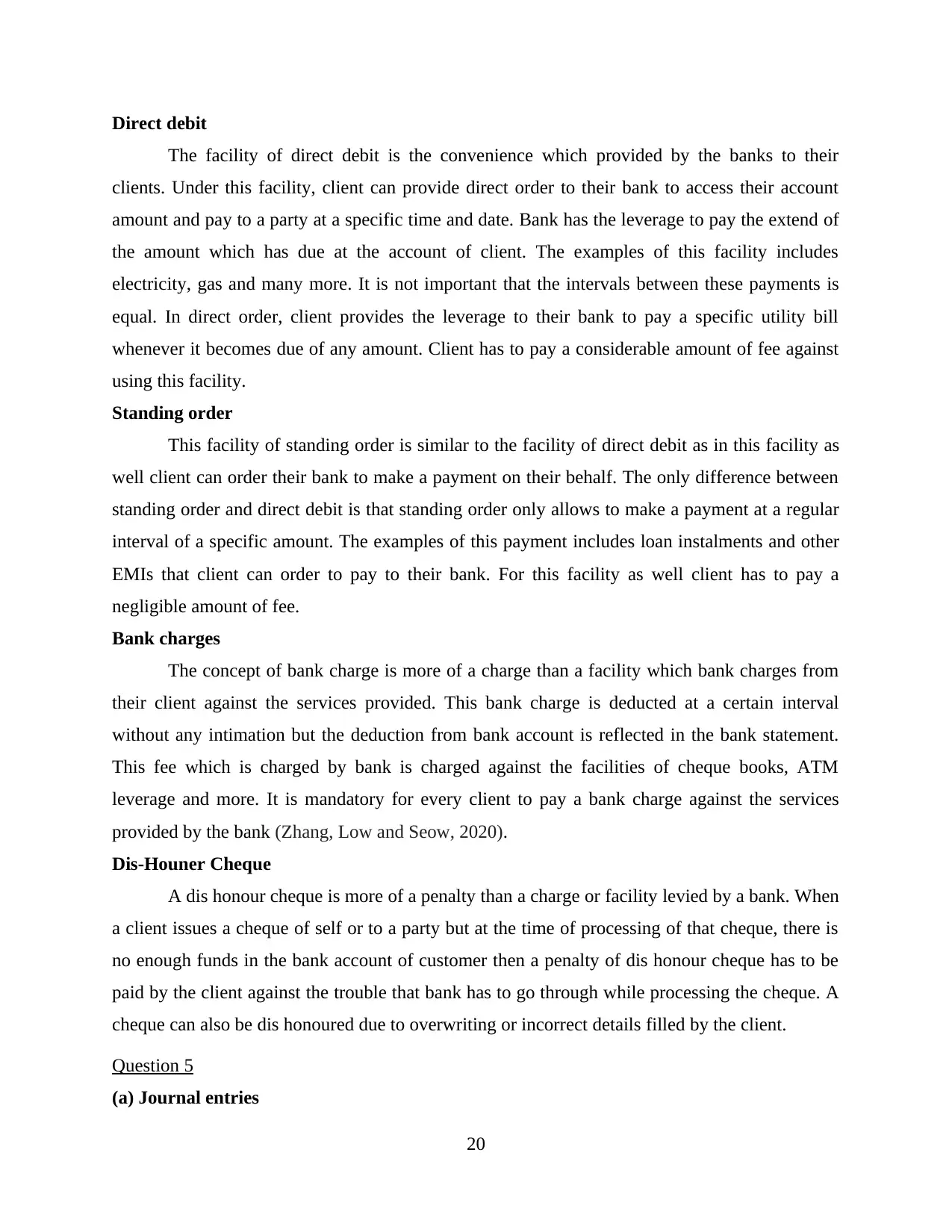
Direct debit
The facility of direct debit is the convenience which provided by the banks to their
clients. Under this facility, client can provide direct order to their bank to access their account
amount and pay to a party at a specific time and date. Bank has the leverage to pay the extend of
the amount which has due at the account of client. The examples of this facility includes
electricity, gas and many more. It is not important that the intervals between these payments is
equal. In direct order, client provides the leverage to their bank to pay a specific utility bill
whenever it becomes due of any amount. Client has to pay a considerable amount of fee against
using this facility.
Standing order
This facility of standing order is similar to the facility of direct debit as in this facility as
well client can order their bank to make a payment on their behalf. The only difference between
standing order and direct debit is that standing order only allows to make a payment at a regular
interval of a specific amount. The examples of this payment includes loan instalments and other
EMIs that client can order to pay to their bank. For this facility as well client has to pay a
negligible amount of fee.
Bank charges
The concept of bank charge is more of a charge than a facility which bank charges from
their client against the services provided. This bank charge is deducted at a certain interval
without any intimation but the deduction from bank account is reflected in the bank statement.
This fee which is charged by bank is charged against the facilities of cheque books, ATM
leverage and more. It is mandatory for every client to pay a bank charge against the services
provided by the bank (Zhang, Low and Seow, 2020).
Dis-Houner Cheque
A dis honour cheque is more of a penalty than a charge or facility levied by a bank. When
a client issues a cheque of self or to a party but at the time of processing of that cheque, there is
no enough funds in the bank account of customer then a penalty of dis honour cheque has to be
paid by the client against the trouble that bank has to go through while processing the cheque. A
cheque can also be dis honoured due to overwriting or incorrect details filled by the client.
Question 5
(a) Journal entries
20
The facility of direct debit is the convenience which provided by the banks to their
clients. Under this facility, client can provide direct order to their bank to access their account
amount and pay to a party at a specific time and date. Bank has the leverage to pay the extend of
the amount which has due at the account of client. The examples of this facility includes
electricity, gas and many more. It is not important that the intervals between these payments is
equal. In direct order, client provides the leverage to their bank to pay a specific utility bill
whenever it becomes due of any amount. Client has to pay a considerable amount of fee against
using this facility.
Standing order
This facility of standing order is similar to the facility of direct debit as in this facility as
well client can order their bank to make a payment on their behalf. The only difference between
standing order and direct debit is that standing order only allows to make a payment at a regular
interval of a specific amount. The examples of this payment includes loan instalments and other
EMIs that client can order to pay to their bank. For this facility as well client has to pay a
negligible amount of fee.
Bank charges
The concept of bank charge is more of a charge than a facility which bank charges from
their client against the services provided. This bank charge is deducted at a certain interval
without any intimation but the deduction from bank account is reflected in the bank statement.
This fee which is charged by bank is charged against the facilities of cheque books, ATM
leverage and more. It is mandatory for every client to pay a bank charge against the services
provided by the bank (Zhang, Low and Seow, 2020).
Dis-Houner Cheque
A dis honour cheque is more of a penalty than a charge or facility levied by a bank. When
a client issues a cheque of self or to a party but at the time of processing of that cheque, there is
no enough funds in the bank account of customer then a penalty of dis honour cheque has to be
paid by the client against the trouble that bank has to go through while processing the cheque. A
cheque can also be dis honoured due to overwriting or incorrect details filled by the client.
Question 5
(a) Journal entries
20
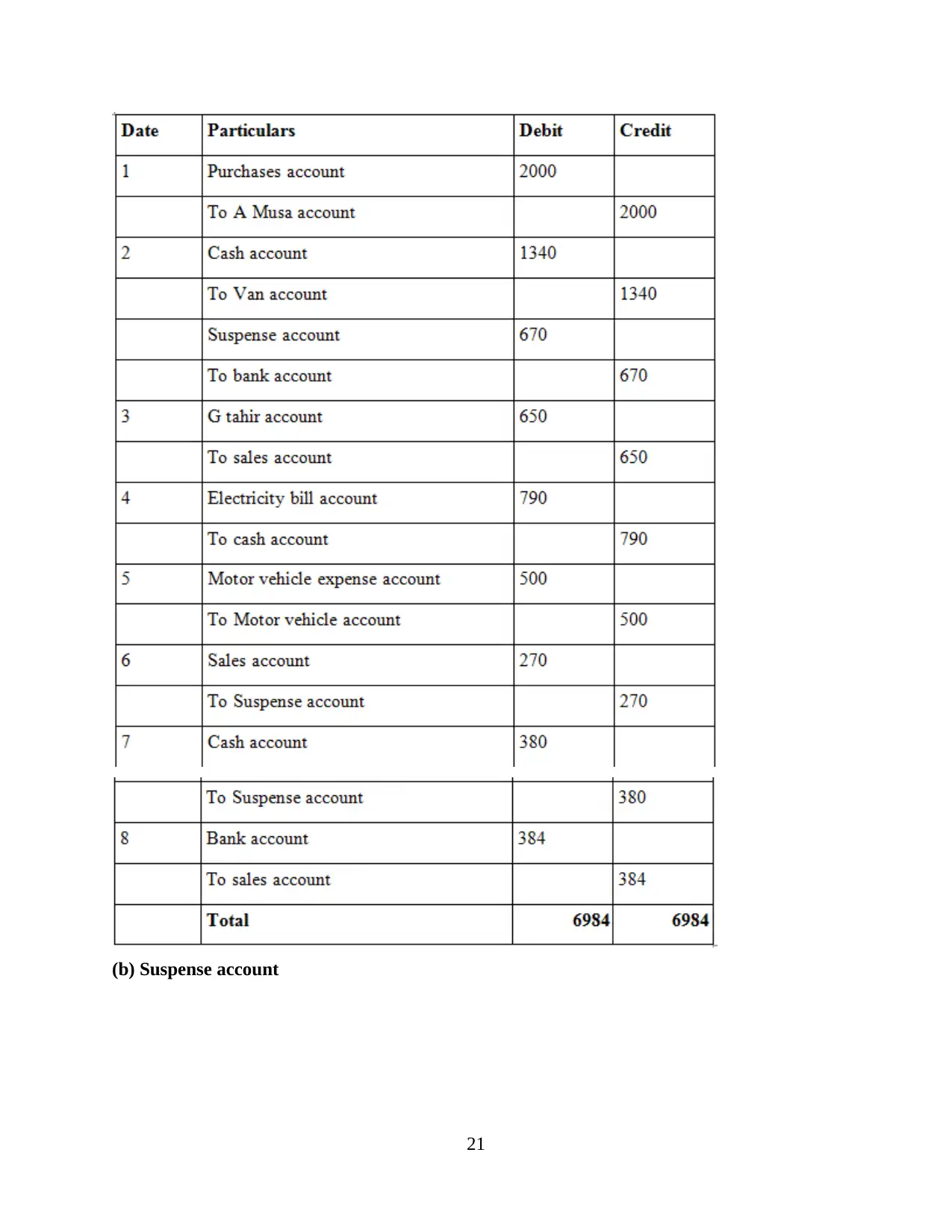
(b) Suspense account
21
21
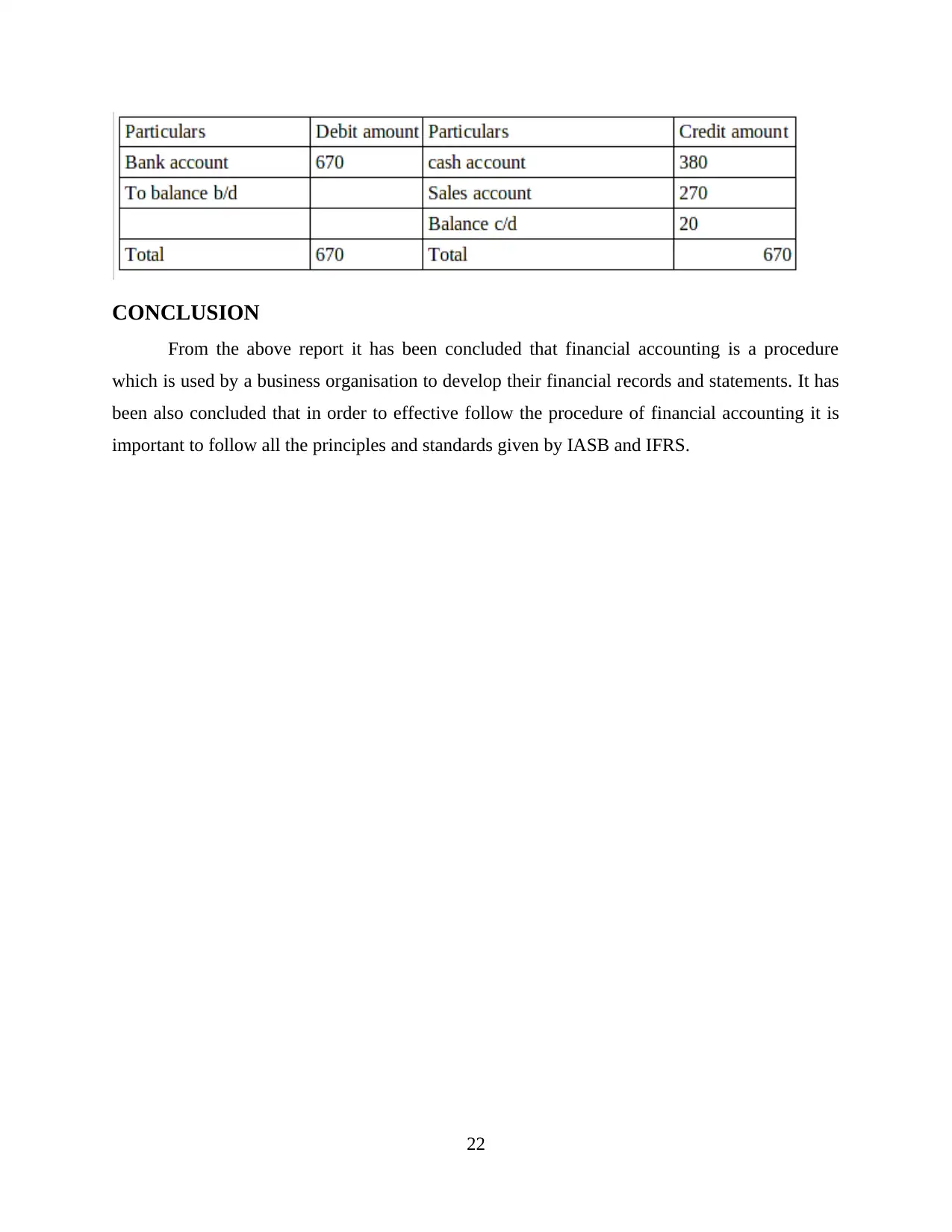
CONCLUSION
From the above report it has been concluded that financial accounting is a procedure
which is used by a business organisation to develop their financial records and statements. It has
been also concluded that in order to effective follow the procedure of financial accounting it is
important to follow all the principles and standards given by IASB and IFRS.
22
From the above report it has been concluded that financial accounting is a procedure
which is used by a business organisation to develop their financial records and statements. It has
been also concluded that in order to effective follow the procedure of financial accounting it is
important to follow all the principles and standards given by IASB and IFRS.
22
Secure Best Marks with AI Grader
Need help grading? Try our AI Grader for instant feedback on your assignments.
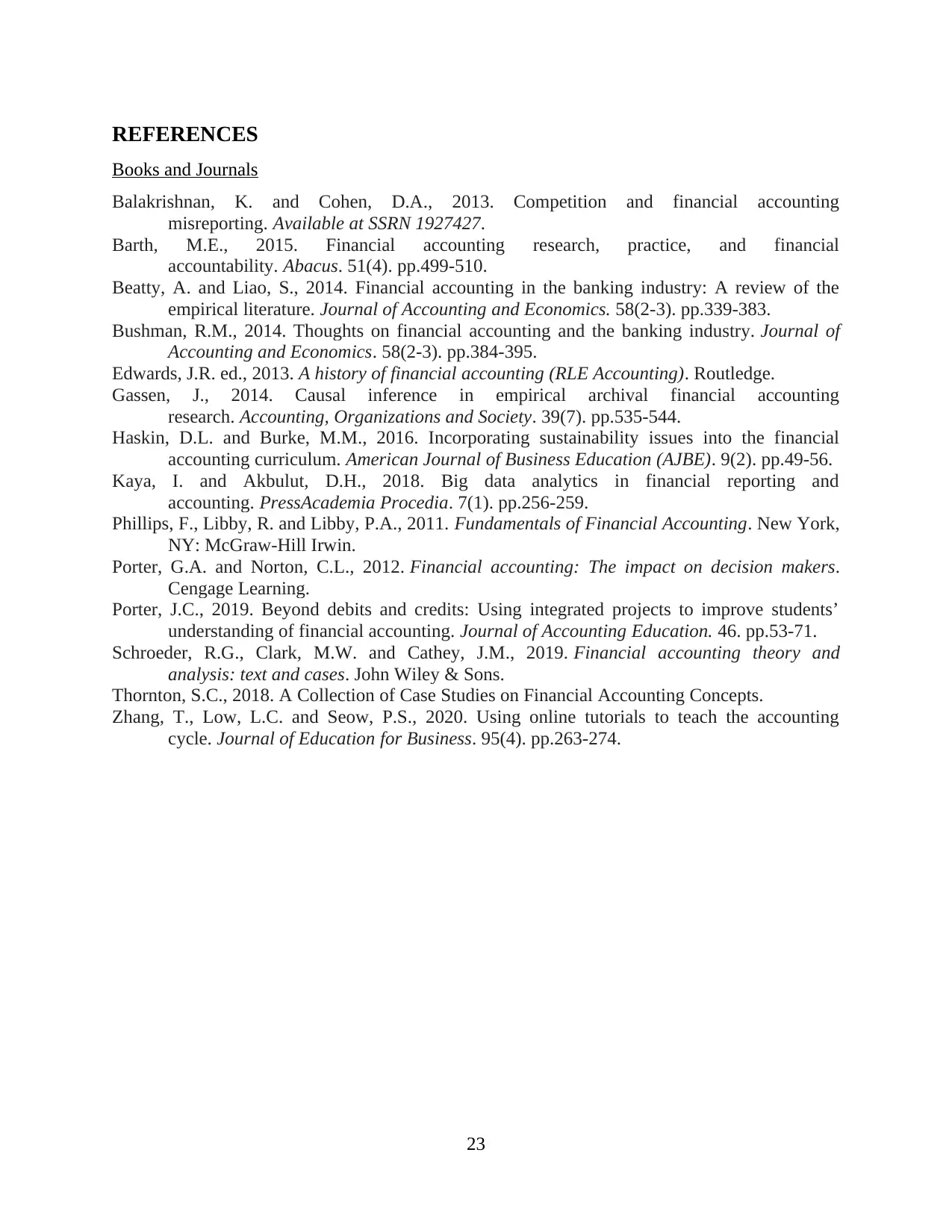
REFERENCES
Books and Journals
Balakrishnan, K. and Cohen, D.A., 2013. Competition and financial accounting
misreporting. Available at SSRN 1927427.
Barth, M.E., 2015. Financial accounting research, practice, and financial
accountability. Abacus. 51(4). pp.499-510.
Beatty, A. and Liao, S., 2014. Financial accounting in the banking industry: A review of the
empirical literature. Journal of Accounting and Economics. 58(2-3). pp.339-383.
Bushman, R.M., 2014. Thoughts on financial accounting and the banking industry. Journal of
Accounting and Economics. 58(2-3). pp.384-395.
Edwards, J.R. ed., 2013. A history of financial accounting (RLE Accounting). Routledge.
Gassen, J., 2014. Causal inference in empirical archival financial accounting
research. Accounting, Organizations and Society. 39(7). pp.535-544.
Haskin, D.L. and Burke, M.M., 2016. Incorporating sustainability issues into the financial
accounting curriculum. American Journal of Business Education (AJBE). 9(2). pp.49-56.
Kaya, I. and Akbulut, D.H., 2018. Big data analytics in financial reporting and
accounting. PressAcademia Procedia. 7(1). pp.256-259.
Phillips, F., Libby, R. and Libby, P.A., 2011. Fundamentals of Financial Accounting. New York,
NY: McGraw-Hill Irwin.
Porter, G.A. and Norton, C.L., 2012. Financial accounting: The impact on decision makers.
Cengage Learning.
Porter, J.C., 2019. Beyond debits and credits: Using integrated projects to improve students’
understanding of financial accounting. Journal of Accounting Education. 46. pp.53-71.
Schroeder, R.G., Clark, M.W. and Cathey, J.M., 2019. Financial accounting theory and
analysis: text and cases. John Wiley & Sons.
Thornton, S.C., 2018. A Collection of Case Studies on Financial Accounting Concepts.
Zhang, T., Low, L.C. and Seow, P.S., 2020. Using online tutorials to teach the accounting
cycle. Journal of Education for Business. 95(4). pp.263-274.
23
Books and Journals
Balakrishnan, K. and Cohen, D.A., 2013. Competition and financial accounting
misreporting. Available at SSRN 1927427.
Barth, M.E., 2015. Financial accounting research, practice, and financial
accountability. Abacus. 51(4). pp.499-510.
Beatty, A. and Liao, S., 2014. Financial accounting in the banking industry: A review of the
empirical literature. Journal of Accounting and Economics. 58(2-3). pp.339-383.
Bushman, R.M., 2014. Thoughts on financial accounting and the banking industry. Journal of
Accounting and Economics. 58(2-3). pp.384-395.
Edwards, J.R. ed., 2013. A history of financial accounting (RLE Accounting). Routledge.
Gassen, J., 2014. Causal inference in empirical archival financial accounting
research. Accounting, Organizations and Society. 39(7). pp.535-544.
Haskin, D.L. and Burke, M.M., 2016. Incorporating sustainability issues into the financial
accounting curriculum. American Journal of Business Education (AJBE). 9(2). pp.49-56.
Kaya, I. and Akbulut, D.H., 2018. Big data analytics in financial reporting and
accounting. PressAcademia Procedia. 7(1). pp.256-259.
Phillips, F., Libby, R. and Libby, P.A., 2011. Fundamentals of Financial Accounting. New York,
NY: McGraw-Hill Irwin.
Porter, G.A. and Norton, C.L., 2012. Financial accounting: The impact on decision makers.
Cengage Learning.
Porter, J.C., 2019. Beyond debits and credits: Using integrated projects to improve students’
understanding of financial accounting. Journal of Accounting Education. 46. pp.53-71.
Schroeder, R.G., Clark, M.W. and Cathey, J.M., 2019. Financial accounting theory and
analysis: text and cases. John Wiley & Sons.
Thornton, S.C., 2018. A Collection of Case Studies on Financial Accounting Concepts.
Zhang, T., Low, L.C. and Seow, P.S., 2020. Using online tutorials to teach the accounting
cycle. Journal of Education for Business. 95(4). pp.263-274.
23
1 out of 23
Related Documents
Your All-in-One AI-Powered Toolkit for Academic Success.
+13062052269
info@desklib.com
Available 24*7 on WhatsApp / Email
![[object Object]](/_next/static/media/star-bottom.7253800d.svg)
Unlock your academic potential
© 2024 | Zucol Services PVT LTD | All rights reserved.





